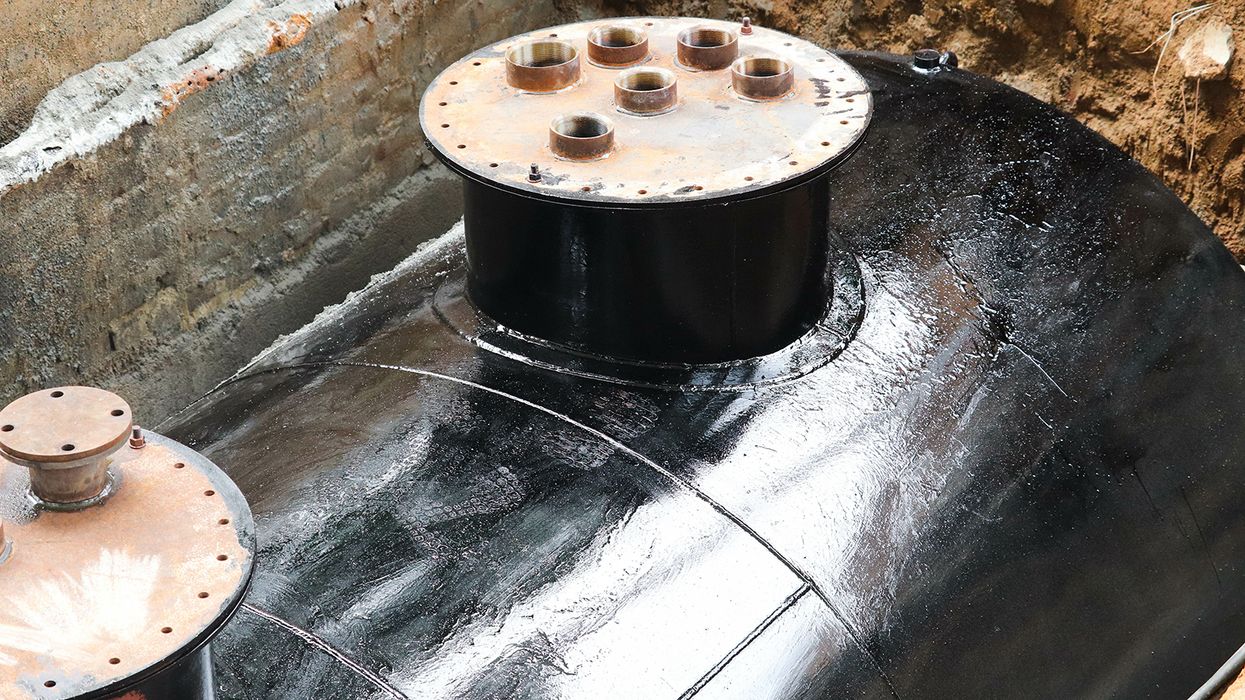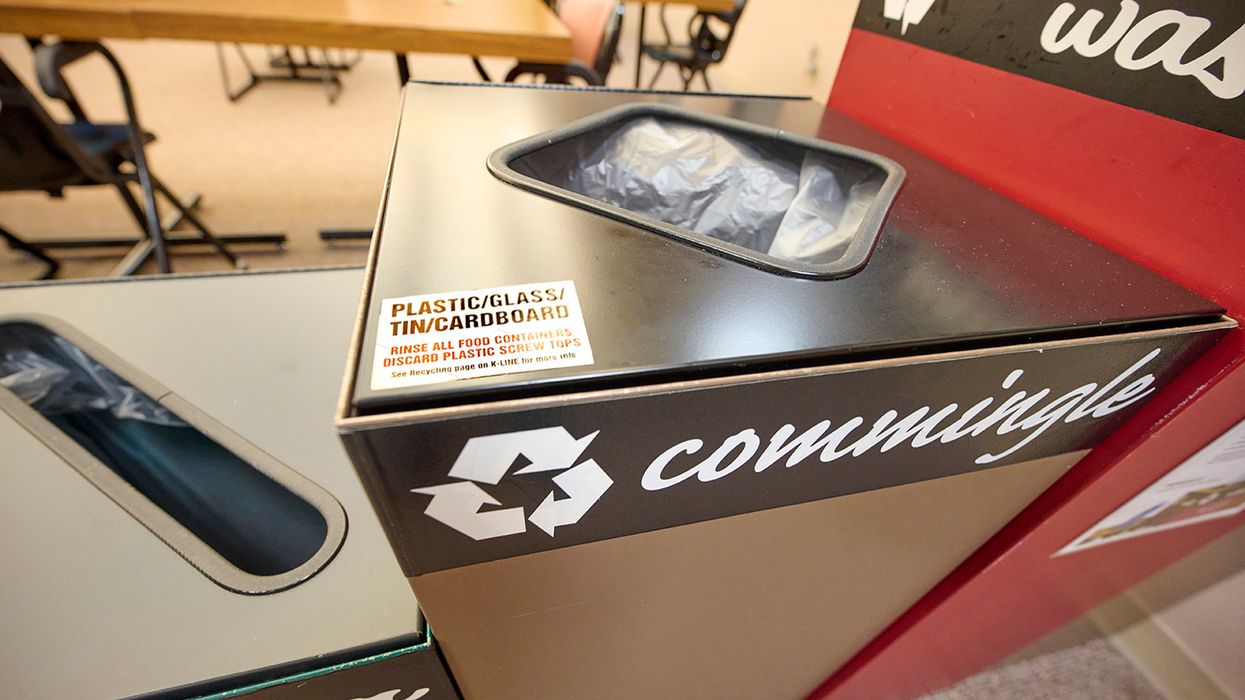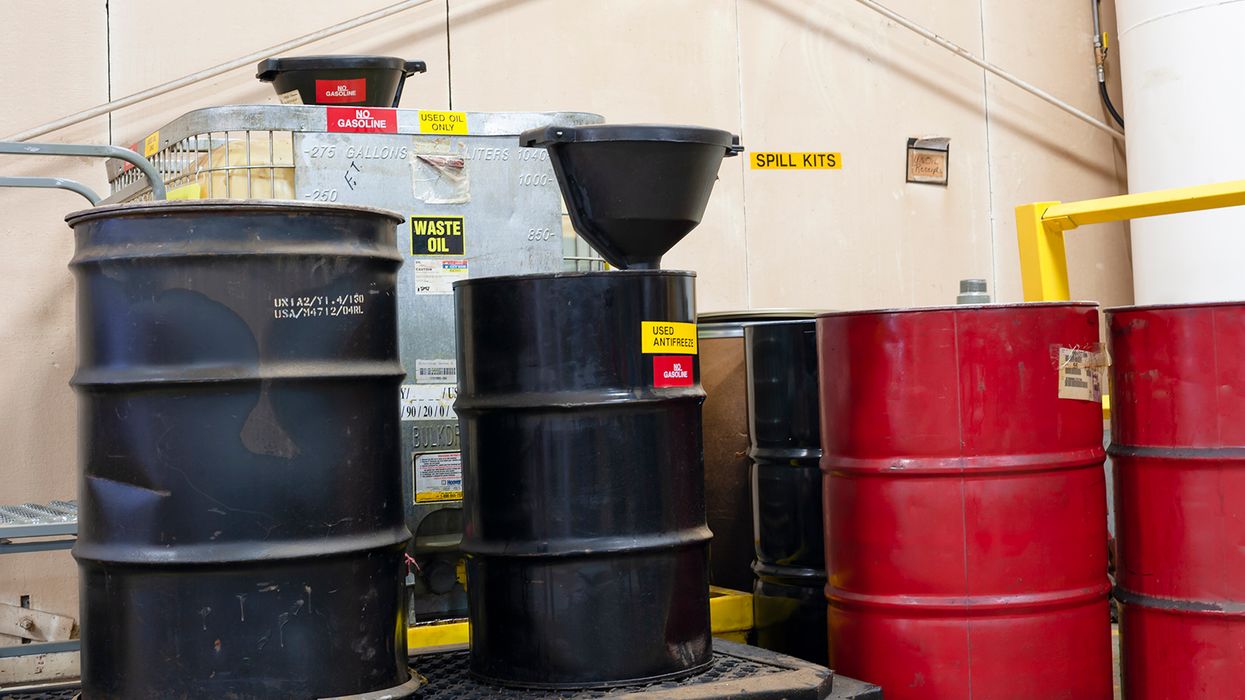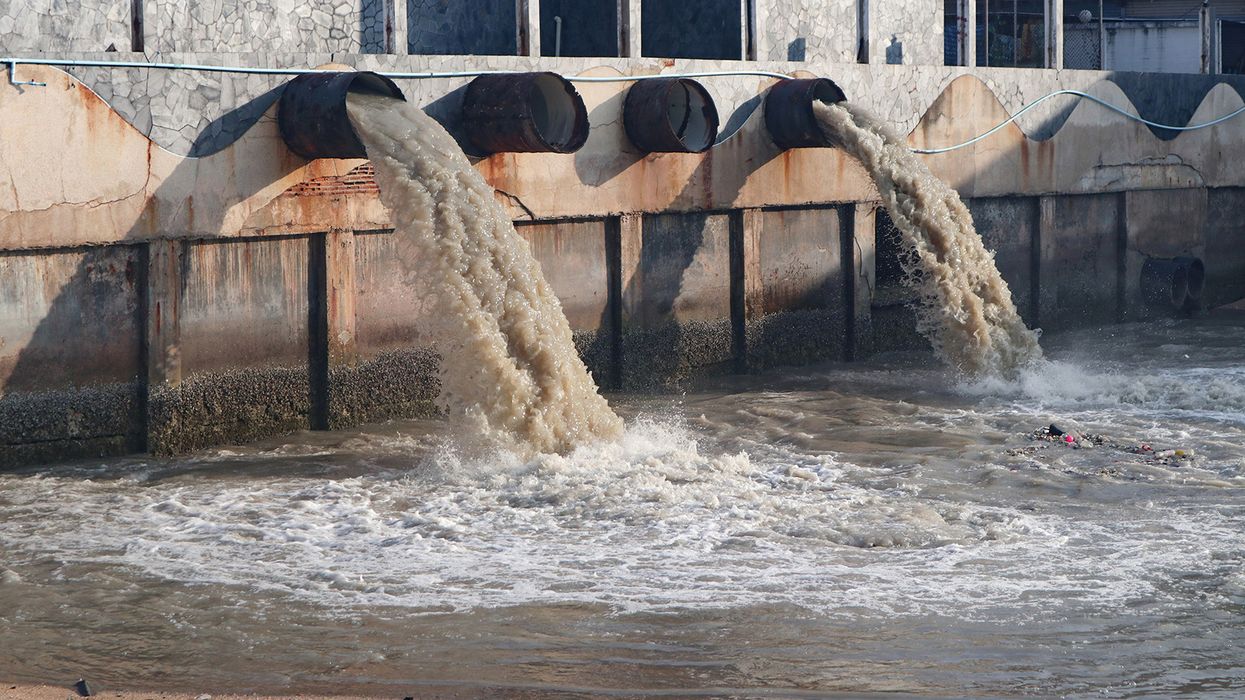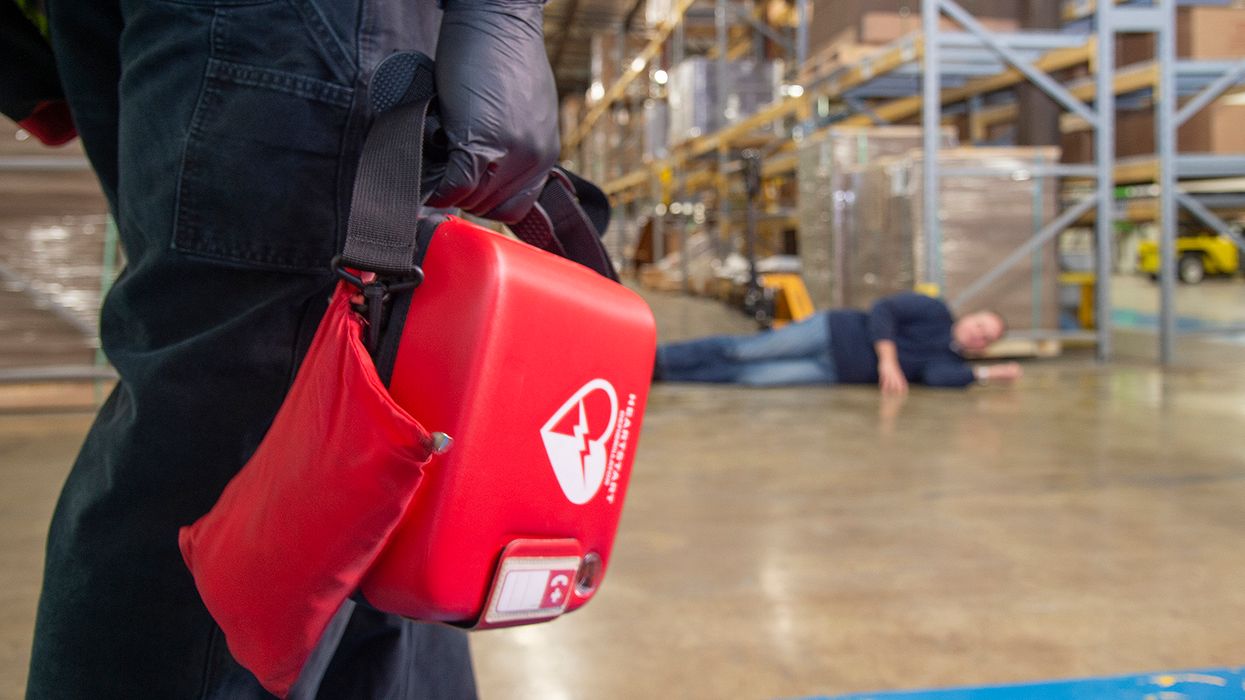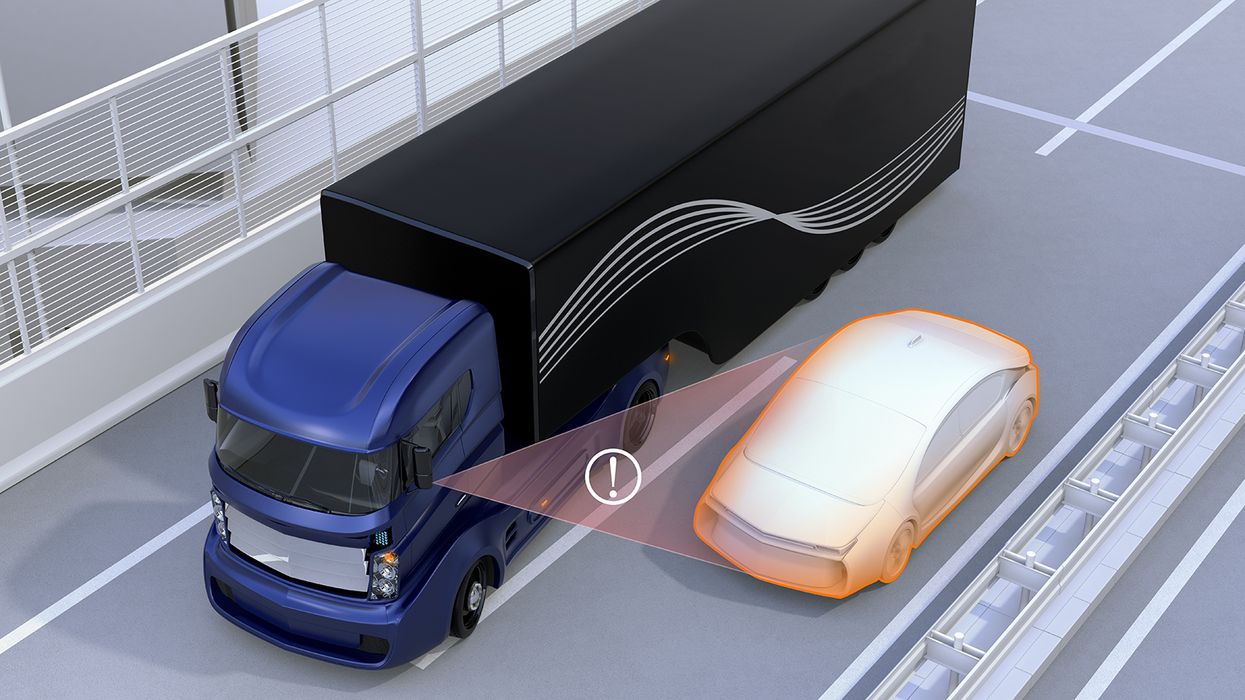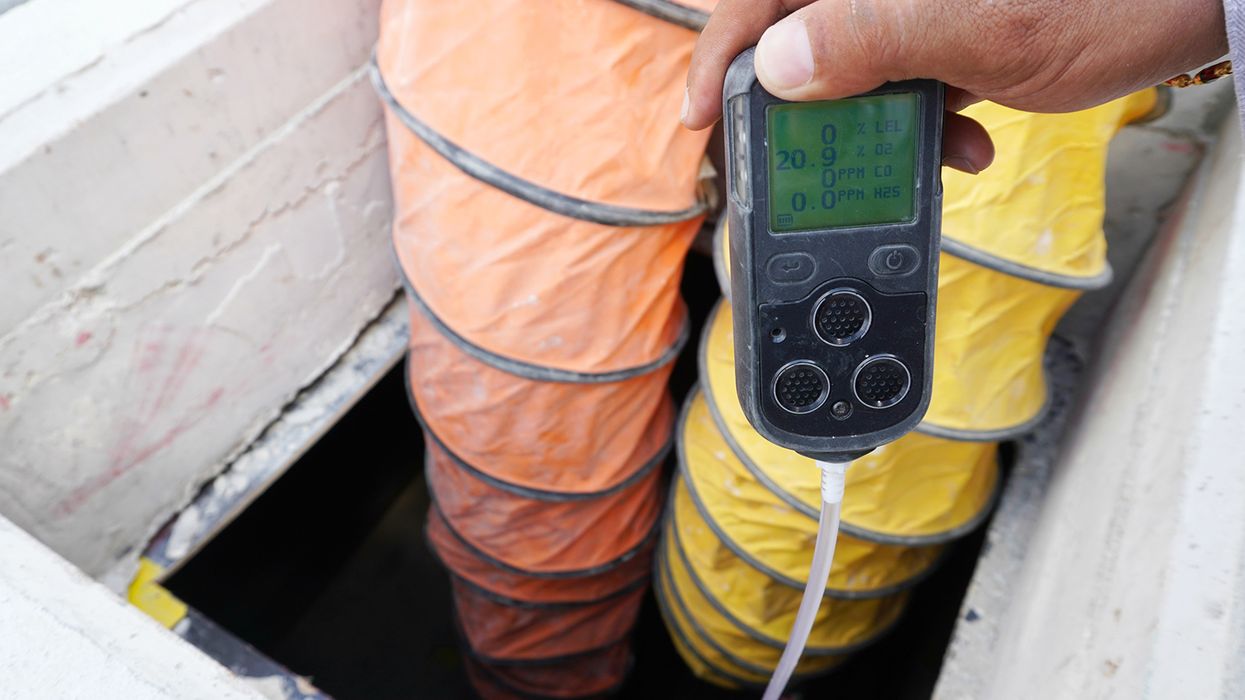[]
[]
2025-05-12T05:00:00Z
JOIN TODAY TO CONTINUE READING THIS ARTICLE & OTHER INDUSTRY NEWS!
You'll also get exclusive access to:
A database of easy-to-understand regulationsAsk unlimited questions to our expertsPre-led discussions forumsAnd more
TRY IT FREE TODAY
Already have an account? Log in now.
See More
RELATED NEWS

Specialized Industries
Go beyond the regulations! Visit the Institute for in-depth guidance on a wide range of compliance subjects in safety and health, transportation, environment, and human resources.
J. J. Keller® COMPLIANCE NETWORK is a premier online safety and compliance community, offering members exclusive access to timely regulatory content in workplace safety (OSHA), transportation (DOT), environment (EPA), and human resources (DOL).

Interact With Our Compliance Experts
Puzzled by a regulatory question or issue? Let our renowned experts provide the answers and get your business on track to full compliance!

Upcoming Events
Reference the Compliance Network Safety Calendar to keep track of upcoming safety and compliance events. Browse by industry or search by keyword to see relevant dates and observances, including national safety months, compliance deadlines, and more.
SAFETY & COMPLIANCE NEWS
Keep up with the latest regulatory developments from OSHA, DOT, EPA, DOL, and more.
REGSENSE® REGULATORY REFERENCE
Explore a comprehensive database of word-for-word regulations on a wide range of compliance topics, with simplified explanations and best practices advice from our experts.
THE J. J. KELLER INSTITUTE
The Institute is your destination for in-depth content on 120+ compliance subjects. Discover articles, videos, and interactive exercises that will strengthen your understanding of regulatory concepts relevant to your business.
ADD HAZMAT, ENVIRONMENTAL, & HR RESOURCES
Unlock exclusive content offering expert insights into hazmat, environmental, and human resources compliance with a COMPLIANCE NETWORK EDGE membership.
DIRECT ACCESS TO COMPLIANCE EXPERTS
Struggling with a compliance challenge? Get the solution from our in-house team of experts! You can submit a question to our experts by email, set up a phone or video call, or request a detailed research report.
EVENTS
Register to attend live online events hosted by our experts. These webcasts and virtual conferences feature engaging discussions on important compliance topics in a casual, knowledge-sharing environment.
Most Recent Highlights In Environmental
NewsHazardous WasteWaste ManifestsWaste/HazWasteSafety and Health Programs and TrainingPesticidesPesticide Registration and LabelingMonthly Roundup VideoFocus Four HazardsUSAInjury and Illness RecordkeepingEnglishIndustry NewsWaste HandlersSafety & HealthInjury and Illness RecordkeepingConstruction SafetyGeneral Industry SafetyWaste300-A Annual SummaryEnvironmentalMine SafetyFocus AreaPesticidesVideo
EHS Monthly Round Up - April 2025
In this April 2025 roundup video, we'll review the most impactful environmental health and safety news.
Hi everyone! Welcome to the monthly news roundup video, where we’ll review the most impactful environmental health and safety news. Let’s take a look at what’s happened over the last month!
On April 17, OSHA released 2024 injury and illness data. This includes information from more than 370,000 establishments that submitted Form 300A, as well as partial data from more than 732,000 Form 300 and Form 301 records. OSHA provides public access to the data in an effort to identify unsafe conditions and workplace hazards that may lead to occupational injuries and illnesses.
This year’s National Stand-Down to Prevent Struck-by Incidents took place the week of April 21. Struck-by incidents are the second leading cause of death among construction workers and the leading cause of nonfatal injuries in the construction industry. The stand-down emphasized the importance of training and prevention on worksites.
A safety alert from the Mine Safety and Health Administration urges the mining community to implement effective safety and health programs, with a focus on identifying and eliminating health and safety hazards. The alert was issued due to a high number of mining fatalities in the first quarter of 2025.
The Mine Safety and Health Administration temporarily paused its silica enforcement for coal mine operators until August 18, four months from its original compliance date of April 14. Under the agency’s silica rule, mine operators must update their respiratory protection programs. This may require them to obtain additional respirators and sampling devices. The agency says this four-month pause provides time for operators to come into compliance.
And finally, turning to environmental news, EPA updated the process for making data corrections to hazardous waste manifests. Waste handlers must correct errors on the manifest within 30 days of a request from EPA or a state agency. They also must submit corrections electronically.
And finally, EPA streamlined its pesticide registration process. The agency updated its MyPest app and made policy changes regarding how to submit two of its registration forms.
Thanks for tuning in to the monthly news roundup. We’ll see you next month!
NewsIndustry NewsWaste GeneratorsWaste/HazWasteWasteEnvironmental Protection Agency (EPA)EnvironmentalIn-Depth ArticleUSAEnglishFocus AreaWaste Reporting
2025-05-08T05:00:00Z
Small quantity generators: Ready for RCRA re-notifications?
You’ve likely never thought of “staying in touch” as a legal obligation, but that’s exactly what it is for facilities that generate small quantities of hazardous waste. The Environmental Protection Agency (EPA) mandates that small quantity generators (SQGs) give updates on their hazardous waste activities every four years. The next re-notification is right around the corner; it’s due by September 1, 2025.
Here's what SQGs need to know to stay in touch — and in compliance — with EPA.
What’s the re-notification requirement?
The Resource Conservation and Recovery Act (RCRA) enables EPA to control hazardous waste from generation to disposal. The agency keeps tabs on SQGs through the re-notification regulation at 40 CFR 262.18(d). It requires SQGs to re-notify EPA or the state environmental agency of their generator status and activities every four years by submitting the:
- Notification of RCRA Subtitle C Activities, also known as the Site Identification (ID) Form (EPA Form 8700-12), or
- State-equivalent form.
How do SQGs re-notify?
Regulated SQGs must submit the Site ID Form. EPA and many states use the myRCRAid module on RCRA Information (RCRAInfo) for re-notifications.
Here’s how to submit the Site ID Form on myRCRAid:
- Log in to RCRAInfo.
- Click “Create New Submission” on the myRCRAid tab.
- Select the reason for submittal as “Obtaining or updating an EPA ID number for on-going regulated activities (Items 10–17) that will continue for a period of time."
- Review and update the information about your site as needed, including the facility’s:
- EPA ID number,
- Name and location address,
- Mailing address,
- Land type,
- North American Industry Classification System (or NAICS) code,
- Site contact information,
- Legal owner/operator information,
- Type of regulated waste activity,
- Additional regulated waste activities, and
- Status as:
- An academic entity with laboratories,
- An episodic generator,
- A large quantity generator (LQG) consolidating very small quantity generator hazardous waste,
- An LQG site closing a Central Accumulation Area or facility,
- A secondary hazardous material manager, and
- A contractor of an electronic manifest broker.
- Include any additional information in the comments section (Item 18).
- Click “Review.” Make any needed corrections to the information. Once this is complete, myRCRAid will display the Review Source Record page.
- Submit the re-notification:
- If you don’t have Certifier permission, click “Mark Ready for Signature.” The application will save the form in the “In Progress” section on myRCRAid and notify individuals at your facility with Certifier and Site Manager permissions. The status will display “Ready for Signature."
- If you have Certifier permission, confirm that the data is correct and click “Sign & Submit” to electronically sign the submission.
Once you submit the Site ID Form, its status on myRCRAid will display “Pending.” EPA or the state regulator will approve or reject the re-notification submission.
Re-notification recommendations
Consider these tips when preparing your SQG re-notification:
- Most RCRA programs are implemented at the state level. Confirm the re-notification regulations with your state environmental agency. It may not use myRCRAid and may require more frequent submissions.
- Ensure you have the necessary RCRAInfo permissions to submit the SQG re-notification. A Preparer can enter information into the Site ID form, but only a Certifier or Site Manager may sign and submit it.
- EPA accepts submission of the Site ID form at any time within the four years before the next re-notification deadline, so you can submit the re-notification before September 1. Verify with your state whether the same allowance applies.
Submitting the SQG re-notification properly keeps EPA updated and your facility compliant.
Key to remember: Small quantity generators of hazardous waste must re-notify EPA or the state agency by September 1, 2025.
NewsIndustry NewsUnderground Storage TanksWaste/HazWasteTank SystemsEnvironmental Protection Agency (EPA)Tank SystemsEnvironmentalIn-Depth ArticleEnglishFocus AreaRelease DetectionUSA
2025-04-24T05:00:00Z
UST release detection equipment: Testing 1, 2, 3
The next time you’re at a service station, consider the fact that you’re standing above underground tanks holding the fuel that you’re pumping into your vehicle. This brings up an important question about any underground tank: Since you can’t see the tank, how do you know if it starts to leak? The answer is a release detection system.
The Environmental Protection Agency (EPA) requires that all regulated underground storage tanks (USTs) have release detection systems and that owners and operators of USTs test the equipment annually to ensure it operates correctly.
Let’s look at three aspects of release detection equipment testing: how to conduct testing, what to test for, and what to record.
1. How do I test the equipment?
UST owners and operators may conduct release detection equipment testing according to:
- The manufacturer’s instructions,
- Industry codes and standards, or
- The implementing agency’s requirements.
Manufacturer’s instructions
Each piece of release detection equipment should have an associated manual or guide for owners to reference. The manual or guide will explain how to test the equipment.
Tip: Most equipment manufacturers provide online versions of their product manuals and guides, which you can likely find on the manufacturer’s website. If you can’t find guidance, contact the manufacturer directly.
Industry codes and standards
EPA’s regulations stipulate that UST owners and operators who follow industry codes and standards must choose ones developed by a nationally recognized association (like ASTM International or the Petroleum Equipment Institute (PEI)) or an independent testing laboratory.
For instance, the agency states at 280.40(a)(3) that UST owners and operators may use PEI/RP1200, Recommended Practices for the Testing and Verification of Spill, Overfill, Leak Detection and Secondary Containment Equipment at UST Facilities, to comply.
Implementing agency requirements
EPA’s rules for testing release detection equipment serve as the minimum standards. Most state regulatory agencies implement UST programs and may impose stricter or additional requirements. Plus, local regulations may apply.
Check state and local rules to ensure your UST complies with the right requirements.
2. What do I test?
At a minimum, UST owners and operators must test the following factors that apply to their release detection systems.
- Automatic tank gauges and other controllers: Test the alarms and battery backups. Verify the system’s configuration.
- Probes and sensors: Test alarm functionality and communication with the controller. Inspect the probes and sensors for residual buildup. Ensure that the floats move freely, the cables have no kinks or breaks, and the shaft isn’t damaged.
- Automatic line leak detectors: Simulate a leak to determine whether the detector meets the operation requirements of 280.44(a).
- Vacuum pumps and pressure gauges: Confirm correct communication with the sensors and controller.
- Handheld electronic groundwater and vapor sampling equipment: Ensure the monitoring equipment operates properly.
3. What records do I have to keep?
The regulation at 280.45(b)(1) mandates that UST owners and operators keep records of the annual release detection equipment testing results for at least three years.
For each annual testing record, list:
- Each device tested,
- If the devices operated according to 280.40(a)(3) or had issues that needed attention, and
- Any corrective actions applied.
Why is release detection equipment testing so important?
Petroleum and other hazardous substances that leak from USTs can endanger human and environmental health. A leaking UST’s primary threat is groundwater contamination. Groundwater supplies drinking water for almost half of Americans.
A release detection system enables a facility to respond sooner to accidental releases and, therefore, limit potential harmful impacts — only if the equipment used for the system operates properly.
Testing your UST’s release detection equipment is vital because it allows you to identify which components function accurately and which parts have problems that need correction. A well-functioning release detection system can help your facility:
- Maintain regulatory compliance (and avoid enforcement actions like penalties),
- Identify opportunities to upgrade existing equipment to improve operational efficiency, and
- Protect your employees and the community in which your facility operates.
Key to remember: EPA requires facilities to test the release detection equipment used on underground storage tanks each year to make sure it operates properly.
NewsIndustry NewsPesticidesSafety & HealthPesticide Registration and LabelingPesticidesGeneral Industry SafetyAgriculture SafetyFederal Insecticide, Fungicide and Rodenticide ActEnvironmentalIn-Depth ArticleEnglishFocus AreaPesticidesUSA
2025-04-23T05:00:00Z
EPA modernizes pesticide registration policy, tweaks tracking app
Pesticide registrations just became simpler, more modern, and more transparent! EPA recently updated an app and made policy changes regarding how to submit two forms. All these changes result in a streamlined pesticide registration process.
Pesticide registration tracking app
On April 18, EPA made enhancements to its MyPest app, which sources say was initially launched in mid-January. EPA is proud to say that MyPest already boasts over 1,200 registrants. The new app allows registrants of pesticide products to:
- Monitor the status of their registration submissions in real-time,
- Drill down to a detailed view of each application, and
- Communicate directly with EPA staff about registration packages in review.
Updates to MyPest include an enhanced dashboard page. The page offers information about the registrant’s cases and products. More updates are planned later this year.
Policy changes impacting two forms
On April 4, EPA announced in the Federal Register the issuance of Pesticide Registration (PR) Notice 2025-1. The notice itself is dated effective March 27, 2025. Its subject line reads, “Revised Procedures for Citing Data to Support Pesticide Registrations (EPA Forms No. 8570-34 and 8570-35).”
The latest PR notice supersedes PR Notice 98-5, dated June 12, 1998. While the revisions were proposed last June, the agency only finalized them now. According to PR Notice 2025-1:
- EPA Form 8570-34 — This is the Certification with Respect to Citation of Data. Pesticide registrants use this form to indicate how they will meet their data submission/citation obligations under the law. When a registrant refers to another company’s data, the registrant must certify that:
- It offered compensation to the original data submitter, or
- It has the original data submitter’s permission to cite the data.
- EPA Form 8570-35 — This is the Data Matrix. Pesticide registrants use this form to indicate to whom they made offers of compensation.
The two forms — EPA Forms 8570-34 and 8570-35 — have not been modified. Only policies regarding the submission of the two forms have changed. The agency:
- Eliminated the instruction to use “paper” submissions;
- Says registrants should complete and submit the two forms electronically through the Pesticide Submission Portal;
- Eliminated the instruction that registrants submit two versions of the Data Matrix, i.e., the ‘‘Internal Agency Use Copy’’ and the ‘‘Public File Copy’’; and
- Requires that registrants submit a single Data Matrix without redactions.
EPA contends that none of the information on Form 8570-35 is confidential. Put another way, none of the information on the Data Matrix is protected from public release. Therefore, the agency claims there is no reason to submit two versions of the form.
According to EPA, entities potentially affected by the policy changes include, but are not limited to:
- Crop production,
- Animal production,
- Food manufacturing, and
- Pesticide manufacturing.
Efficiencies and transparencies gained
Using electronic reporting for EPA Forms 8570-34 and 8570-35 brings efficient data transmittal, argues EPA. A bonus is that electronic reporting will also reduce errors. That’s because of automated validation tools in the portal. Submitters should experience lower costs and faster review and transmission of data, the agency adds.
In 2024, EPA received a total of 3,309 Data Matrices. Moving from two versions to just one for the Data Matrix form should save registrants and EPA time. Specifically, completing, submitting, and processing the Data Matrix should be quicker. EPA will also experience time savings when providing the public access to the information. Extra steps under the Freedom of Information Act would not be needed.
The MyPest app update is a step forward in efficiency and transparency, concludes EPA. The app enhancements are part of the agency’s overall move toward digital and streamlined processes. EPA projects that the app will improve the timeliness of pesticide registration decisions.
Key to remember
Recent actions streamline the pesticide registration process and make it more transparent. These actions relate to the MyPest app and EPA Forms 8570-34 and 8570-35.
NewsIndustry NewsWaste/HazWasteRecyclingEnvironmentalIn-Depth ArticleEnglishSustainabilityFocus AreaUSA
2025-04-17T05:00:00Z
Workplace recycling in 2025: Why it matters now more than ever
Think recycling at work is just tossing paper in a blue bin? Think again. In 2025, workplace recycling is being redefined — from a basic office task to a strategic initiative that impacts your company’s bottom line, brand reputation, and environmental footprint.
From cardboard and plastics to e-waste and food scraps, today’s leading businesses are building smarter, circular systems that turn trash into opportunity — one department at a time.
Here are five reasons why recycling matters now more than ever.
1. Environmental responsibility impacts your brand reputation
Sustainability is no longer just a corporate social responsibility (CSR) talking point. It’s a core business differentiator. As a management or EHS leader, you’re often on the frontlines of implementing the visible changes that shape public perception. Recycling programs are a low-barrier, high-impact initiative that sends a clear message to customers, investors, and employees: We walk the talk.
Failing to prioritize environmental responsibility puts your company’s reputation at risk — especially in industries with public visibility or regulatory scrutiny. Forward-thinking competitors are already using circular economy models and zero-waste initiatives to win market share.
Champion a program that reflects your company’s values and positions you as a sustainability leader in your field.
2. Compliance with local, state, and federal regulations
Recycling is no longer a “nice-to-have.” Many jurisdictions now require commercial recycling, especially for packaging waste, e-waste, and food scraps. Increasingly, regulations also demand data transparency, such as tracking waste volumes, diversion rates, and sustainability goals.
Supervisors in environmental and safety roles are responsible for ensuring compliance and minimizing risk. Violations can result in hefty fines, bad press, or loss of contracts.
Stay ahead of compliance trends and implement a recycling program that satisfies current and future requirements while keeping auditreadiness top of mind.
3. Cost savings and operational efficiency
Landfill disposal is becoming more expensive due to tipping fees and transportation costs. By diverting materials through recycling or reuse programs, companies can reduce both their environmental footprint and their operational spend.
In addition, smart material handling and waste segregation can lead to process improvements — less clutter, fewer hauling pickups, and even opportunities to monetize recyclable materials like scrap metal, cardboard, or used electronics.
Use data from your waste audits and vendor reporting to identify high-volume waste streams and optimize for both cost reduction and resource efficiency.
4. Workforce engagement, retention, and culture
Today’s workforce, particularly younger employees, is drawn to employers who align with their values. A clean, green workplace that visibly supports recycling and sustainability reinforces a positive culture, boosts morale, and improves engagement — especially when employees feel like they’re contributing to something bigger.
Recycling initiatives are also an easy win for cross-departmental engagement. Whether through green teams, signage campaigns, or employee challenges, these programs offer hands-on ways to involve everyone.
Build internal buy-in by showing how your initiatives support company values, employee wellness, and sustainability goals through shared responsibility.
5. Alignment with data-driven ESG and sustainability goals
In 2025, companies are under increasing pressure from stakeholders to report measurable progress on environmental, social, and governance (ESG) initiatives. Waste reduction, recycling rates, and landfill diversion metrics are among the top data points requested in annual sustainability reports and RFPs.
Supervisors and EHS leaders are often the owners of the data. You're tasked with tracking, verifying, and reporting on these outcomes. Without a structured recycling program in place, those metrics are impossible to capture, and your ESG report falls flat.
Establish a system for measuring, improving, and communicating progress toward zero-waste or landfill diversion targets, and support leadership in meeting ESG benchmarks.
Key to remember: Embracing workplace recycling in 2025 isn’t just good for the planet — it’s a smart move that drives innovation, saves money, and positions your company as a leader in sustainability.
Most Recent Highlights In Transportation
NewsEnforcement and Audits - OSHAWaste/HazWasteSafety and Health Programs and TrainingOil RefineriesVideoMonthly Roundup VideoWalking Working SurfacesMiningGrain HandlingFocus Four HazardsUSALaddersEnglishAir ProgramsIndustry NewsEnforcement and Audits - OSHASafety & HealthConstruction SafetyGeneral Industry SafetyWasteSpecialized IndustriesEnvironmentalAir QualityFocus AreaMine SafetyAir ProgramsWaste Reporting
EHS Monthly Round Up - March 2025
In this March 2025 roundup video, we'll review the most impactful environmental health and safety news.
Hi everyone! Welcome to the monthly news roundup video, where we’ll review the most impactful environmental health and safety news. Let’s get started!
Ladders were the cause of over 22,000 workplace injuries and 161 deaths in 2020. Each March, the American Ladder Institute promotes ladder safety awareness with the goal of reducing ladder-related injuries and fatalities. Every Step Matters was the theme of this year’s National Ladder Safety Month.
Stand Up 4 Grain Safety Week kicked off on March 24. This annual event brings attention to preventable grain handling hazards and promotes safety in this high-hazard industry.
Federal agencies must review their regulations and report back to the White House by April 20. The priority is on “significant” rules, generally considered to be those with an annual effect on the economy of 100 million dollars or more. Once the regulations have been identified, the Office of Management and Budget and the Department of Government Efficiency will work with agency leaders to create a plan for rescinding or modifying the regulations and begin winding down their enforcement.
A highwall fatality at a surface mine prompted the Mine Safety and Health Administration to issue a safety alert. It outlines what miners should do to prevent similar incidents, including looking for hazards such as loose rocks and overhangs before beginning work.
The American Society of Safety Professionals revised its construction training standard. It outlines training requirements for new hires in construction and demolition operations, site procedures, regulatory compliance, and more.
And finally, turning to environmental news, EPA will reconsider a number of major rulemakings that may impact a variety of industries. This is in response to an executive order that federal agencies review their regulations. Among the rules under consideration include those related to clean power, oil and gas emission limits, greenhouse gas reporting, and risk management.
EPA’s Waste Emissions Charge on petroleum and natural gas facilities with high methane emissions is no longer in effect. The rule initially took effect in January and was then disapproved by Congress on March 14.
Thanks for tuning in to the monthly news roundup. We’ll see you next month!
NewsIndustry NewsWaste ManifestsWaste/HazWasteWasteEnvironmental Protection Agency (EPA)EnvironmentalIn-Depth ArticleEnglishFocus AreaUSA
2025-04-04T05:00:00Z
Hazardous waste manifest errors? Follow RCRA’s correction process
Hazardous waste manifests are like travel logs. They track the entire journey of regulated hazardous waste, from the starting point (the generator’s facility) to the final destination (the off-site waste management facility). Like travel logs, a manifest is only as accurate as the information provided. Thankfully, you can correct manifest errors.
The Environmental Protection Agency (EPA) finalized the Third Rule under the Resource Conservation and Recovery Act (RCRA), which took effect in January 2025. It made noteworthy changes to the manifest corrections process. Here’s what hazardous waste generators, transporters, and treatment, storage, and disposal facilities (TSDFs) need to know.
Who’s impacted?
The Third Rule impacts entities subject to RCRA’s manifest regulations. This article focuses on the manifest correction rules that apply to these waste handlers:
- Small and large quantity generators,
- Transporters, and
- TSDFs.
Note that the final rule amends post-manifest correction regulations for other entities, such as exporters, that are beyond the scope of this article.
What are the Third Rule changes?
EPA’s final rule maintains most of the post-receipt manifest data corrections process.
What’s the same?
Specifically:
- Any waste handler named on the manifest may voluntarily submit data corrections at any time,
- Waste handlers can make an unlimited number of voluntary corrections,
- Corrections may be applied to an individual record or batch of them, and
- Submissions must include a signature compliant with the Cross-Media Electronic Reporting Rule (CROMERR).
What’s different?
Previously, when EPA or a state regulatory agency requested corrections to data on a manifest, waste handlers weren’t required to make them. The Third Rule now mandates that waste handlers:
- Correct errors on the manifest within 30 days of a corrections request from EPA or a state agency, and
- Make data correction submissions electronically for paper or electronic manifest records.
Post-receipt corrections are made via the Hazardous Waste Electronic Manifest System (e-Manifest) on the RCRA Information (RCRAInfo) system.
The Third Rule also clarifies that receiving facilities (TSDFs) can make corrections only after the manifest is completed (i.e., signed and submitted to the e-Manifest system).
What’s the post-receipt manifest correction process?
Waste handlers submitting voluntary or mandatory post-receipt corrections to hazardous waste manifests must follow the process established at 40 CFR 264.71(l).
Follow this general process on the e-Manifest System:
- Certify that the manifest is complete. It must have the status “Signed-Completed."
- Determine how to submit the corrected data to the e-Manifest system. You can enter the data directly into e-Manifest or upload a file with data corrections to the system.
- Include for each correction submission:
- The Manifest Tracking Number and date received by the facility associated with the data being corrected,
- The Item Number(s) of the affected data fields on the manifest form (EPA Form 8700-22), and
- The previously entered and corrected data.
- Save your corrections. The manifest’s status will change to “Under Correction."
- Re-sign the manifest to certify the corrections. The manifest’s status will change to “Corrected."
Manifest correction FAQs
Check out some top questions and answers about post-receipt manifest corrections.
What manifest information can I correct?
The type of waste handler your facility is determines which items on the manifest you can change for voluntary corrections or must change for mandatory corrections. Typically:
- Generators correct data in Items 1–15;
- Transporters correct data in Items 6–7, 14, and 17; and
- TSDFs correct data in Items 14 and 18–20.
What user role do I need on RCRAInfo to submit manifest corrections?
You must be registered in RCRAInfo as a user with the e-Manifest Certifier or Site Manager role for the facility’s site to submit manifest corrections.
What’s the CROMERR certification?
EPA requires manifest correction submitters to use a CROMERR-compliant electronic signature, which requires a higher level of identity proofing than the Quick Sign signature.
Can I revert to a previous manifest version?
Once the corrected manifest has been signed, you can’t revert it to a previous version. The e-Manifest system does, however, let you view all versions of the manifest.
Can brokers sign corrected manifests?
Although brokers can initiate a manifest correction for generators, they may not sign a corrected manifest unless they (a) operate at the generator’s facility and (b) can sign the manifest as an offeror of the waste shipment.
Key to remember: EPA’s Third Rule updates the process for making data corrections to RCRA hazardous waste manifests.
NewsHazardous WasteIndustry NewsWaste/HazWasteWasteEnvironmentalIn-Depth ArticleEnglishFocus AreaUSA
2025-04-01T05:00:00Z
The cost of cutting corners: What a toxic fire teaches us about waste management
Are you storing and disposing of hazardous waste correctly or sitting on a disaster? Hazardous waste storage is not just a regulatory headache — it is a time bomb for the environment and your company’s bottom line. A disaster in East London, England, is an ongoing issue for nearby residents that highlights the importance of hazardous waste management and why employers must take it seriously.
What happened?
Originally intended for construction waste disposal, the site eventually turned into a dumping ground for hazardous industrial materials. Investigations found plastics, asbestos, industrial chemicals, and carcinogenic substances illegally dumped, creating an environmental and public health hazard. These materials fuel fires, continuously releasing toxic smoke into the air. Residents have reported respiratory problems, skin irritation, and other health issues while authorities struggle to contain the situation. Even though this incident occurred in London, we can learn plenty of valuable lessons from it. Here’s how employers can take proactive measures to ensure compliance, protect workers, and prevent environmental harm.
1. Implement a robust hazardous waste management plan
A hazardous waste management plan should:
- Include waste classifications (reactive, corrosive, etc.) and an inventory of all hazardous materials used and generated;
- Ensure all storage and handling procedures, including labeling, segregation of incompatible waste, spill prevention, and containment measures, are followed;
- Document all waste accumulation and disposal methods, specifying the storage time limits for waste and the methods used for its disposal, such as incineration, recycling, or third-party handling; and
- Provide information on personal protective equipment (PPE) requirements, emergency contact information, reporting procedures, and an evacuation plan in case of a spill.
2. Train employees on hazardous waste handling
Train personnel on their roles and responsibilities when handling hazardous waste. Training should include:
- Initial and refresher training that complies with the Resource Conservation and Recovery Act (RCRA) and state laws,
- Identifying unsafe practices and reporting potential violations.
3. Conduct routine inspections and audits
- Perform internal audits to ensure compliance with RCRA regulations.
- Schedule third-party audits to identify risks and areas of improvement.
- Create a corrective action plan for any violations or inefficiencies discovered during audits.
4. Use licensed and certified waste disposal services
The primary reason behind illegal waste dumping is financial. We all know it is not cheap to dispose of hazardous waste, but waste generators are responsible for their waste from “cradle to grave.”
- Conduct due diligence to verify disposal methods to prevent third-party illegal dumping.
- Maintain records of manifest, disposal certificate, and compliance documentation.
5. Secure and label waste properly
- Labels should include “hazardous waste” clearly visible on the container, generator information, accumulation start date, proper shipping name, and waste identification.
- Store hazardous waste in compatible containers to prevent leaks or spills.
6. Reduce hazardous waste by using safer alternatives
One of the most effective ways to prevent hazardous waste incidents is to reduce reliance on them in the first place. By switching to safer alternatives, employers can lower their risk of exposure. Industries now offer eco-friendly coatings, adhesives, and cleaning agents that perform well without all the side effects. Safer alternatives also reduce compliance costs by lowering the burdens for hazardous waste disposal.
The disaster in London is a stark reminder of the consequences of negligent hazardous waste management. Businesses that cut corners on waste disposal risk legal penalties and contribute to long-term environmental and public health damage.
Keys to remember: Employers can protect their workforce, comply with regulations, and prevent environmental disasters by adopting proactive waste management strategies.
NewsGreenhouse GasesIndustry NewsIndustry NewsEnvironmental Protection Agency (EPA)Air ProgramsEnvironmentalAir QualityEnglishFocus AreaUSA
2025-03-25T05:00:00Z
Congress disapproves EPA's excess methane fees on oil, gas facilities
A joint Congressional resolution disapproved the 2024 Final Waste Emissions Charge (WEC) Rule on oil and gas facilities with high methane emissions. The Environmental Protection Agency (EPA) announced that the regulation, which initially took effect on January 17, 2025, is now no longer in effect.
Who’s impacted?
The WEC rule applied to facilities in the Petroleum and Natural Gas Systems category that:
- Report emitting more than 25,000 metric tons of carbon dioxide equivalent per year to the Greenhouse Gas Reporting Program (or GHGRP),
- Exceed specific waste emissions thresholds, and
- Qualify for no exemptions.
Facilities that were subject to the rule are no longer required to comply (i.e., submit WEC filings by September 2, 2025).
What’s next?
EPA stated it’s “currently evaluating options and obligations for implementing Clean Air Act Section 136(c–g) and will provide additional information to the regulated community at an appropriate time."
Section 136, added by the Inflation Reduction Act of 2022, mandates that EPA implement a methane reduction incentive program for petroleum and natural gas systems, including imposing and collecting a WEC on methane emissions above waste emissions limits.
The disapproval occurred on March 14, 2025, just two days after the agency announced 31 deregulatory actions it plans to take.
Key to remember: EPA’s Waste Emissions Charge on petroleum and natural gas facilities for excess methane is no longer in effect.
NewsWaste/HazWasteWasteWater ProgramsWater QualityWater ProgramsEnglishAir ProgramsIndustry NewsIndustry NewsWasteEnvironmentalAir QualityFocus AreaAir ProgramsUSA
2025-03-19T05:00:00Z
EPA announces major regulatory reviews, overhauls
The Environmental Protection Agency (EPA) announced on March 12, 2025, that it’s taking 31 actions to advance President Trump’s Day One executive orders and the new “Powering the Great American Comeback” Initiative. The agency’s actions will likely impact environmental regulations across various industries.
Rules under review
EPA will reconsider an assortment of rulemakings, including:
- The Clean Power Plan 2.0 (which sets carbon dioxide emission limits on new gas-fired combustion turbines and emissions guidelines for existing coal, oil, and gas-fired steam generating units),
- Oil and gas emission limits for new and existing sources (40 CFR Part 60 Subparts OOOOb and OOOOc),
- The Greenhouse Gas (GHG) Reporting Program (GHGRP) for petroleum and natural gas systems (Part 98 Subpart W),
- The GHGRP overall (Part 98),
- Mercury Air Toxics Standards for coal- and oil-fired power plants (Part 63 Subpart UUUUU),
- Effluent limitation guidelines (ELGs) for the steam electric power generating industry (Part 423),
- Treated wastewater use and discharge for coal-fired power plants (Part 435 Subpart E),
- The Risk Management Program rule (Part 68),
- Vehicle GHG rules (including the light-, medium-, and heavy-duty vehicle regulations),
- The 2009 Endangerment Finding (relied on for seven federal vehicle rules) and related regulations and actions (Chapter I),
- The Technology Transition Rule for refrigerant systems (Part 84 Subpart B),
- The National Ambient Air Quality Standards for fine particulate matter (Parts 50, 53, and 58),
- The National Emission Standards for Hazardous Air Pollutants (Part 63) for:
- Iron and steel manufacturing,
- Rubber tire manufacturing,
- Synthetic organic chemical manufacturing,
- Commercial sterilizers for medical devices and spices,
- Lime manufacturing,
- Coke ovens,
- Copper smelting, and
- Taconite ore processing.
- The Exceptional Events rulemaking related to allowing prescribed fires within State Implementation Plans (Parts 50–51),
- The Regional Haze Program implementing regulations (51.308), and
- The Good Neighbor Plan (Parts 52, 75, 78, and 97).
The agency will also take other actions, such as:
- Working with the U.S. Army Corps of Engineers to finalize the definition of “waters of the United States” related to Clean Water Act permits,
- Updating enforcement discretion by revising the National Enforcement and Compliance Initiatives, and
- Prioritizing the coal ash program to expedite state permit reviews and update the coal ash regulations (including amending the Legacy Coal Combustion Residuals Surface Impoundments and CCR Management Units rule).
About EPA’s new initiative
In February 2025, the agency announced the Powering the Great American Comeback Initiative, which outlines EPA’s priorities. The initiative consists of five pillars:
- Clean air, land, and water;
- Restore energy dominance;
- Permitting reforms, cooperative federalism, and cross-agency partnership;
- Make the U.S. the artificial intelligence capital of the world; and
- Protect and bring back American auto jobs.
EPA’s 31 actions will primarily address the first three pillars.
Key to remember: EPA will reconsider major rulemakings that may impact a variety of industries.
Most Recent Highlights In Safety & Health
NewsProcess Safety ManagementRisk Management ProgramRisk Management ProgramHAZWOPERIn-Depth ArticleEnglishEmergency Planning - OSHAIndustry NewsHAZWOPER Emergency ResponseSafety & HealthConstruction SafetyEmergency Planning (OSHA)General Industry SafetyAgriculture SafetyMaritime SafetyEnvironmentalAir QualityHazardous Materials Safety - OSHAFocus AreaUSA
2025-03-17T05:00:00Z
Lessons from blast: CSB video explores gas detection and emergency plans
Another riveting video is posted by the Chemical Safety and Hazard Investigation Board (CSB)! The animated video covers a massive explosion at a Texas machine shop. Two workers and a member of the public were killed. Over 450 neighboring homes/businesses were damaged.
Video supports investigative report
The 14-minute video, “No Detection: Explosion …,” follows a June 2023 investigation report. When the 56-page report came out, CSB Chairperson Steve Owens said, “Our investigation found that [the company] did not have an effective program in place to assess potential hazards in its propylene process and did not have a mechanical integrity program or written operating procedures.”
The incident was compounded by emergency planning failures, says CSB. Owens argued, “This tragic incident was made even worse due to the lack of emergency response training for employees at the facility.”
Deadly incident
CSB explains that a degraded and poorly crimped rubber welding hose disconnected from its fitting inside a coating booth. That prompted a release of propylene, a flammable vapor.
By the time workers arrived at the facility the early morning of January 24, 2020, an explosive concentration of propylene had formed inside the building. As workers entered and turned on the lights, the vapor ignited, triggering an explosion. It:
- Killed two workers,
- Injured two other workers,
- Fatally injured a nearby resident, and
- Damaged hundreds of structures.
The board’s investigation later found that the company had:
- Disconnected gas detectors from a computer control system. This meant the automatic gas detection shutoff system would not alert operators to a leak. It also would not start up exhaust fans or trigger two shutoff valves to stop the flow of propylene.
- Replaced a copper tubing connection with a rubber welding hose. Rubber hose is not recommended for propylene. Oils in the gas can cause a rubber hose to form cracks and lose pliability.
OSHA citations before/after the incident
OSHA cited the company 12 years earlier for failing to inspect gas system equipment for signs of deterioration or leaks. The 2008 OSHA visit was prompted by another explosion of propylene gas.
Following the later 2020 incident, OSHA issued citations for failing to:
- Provide effective training on chemical hazards,
- Prevent explosive concentrations from accumulating,
- Ensure coating equipment was maintained gas-tight, and
- Ensure the manual shutoff valve at the propylene storage tank was closed at the end of each workday.
Safety issues found by CSB
CSB explains that the shop’s propylene amount was below the threshold for OSHA’s Process Safety Management (PSM) standard at 29 CFR 1910.119 or EPA’s Risk Management Plan (RMP) standard at 40 CFR 68. Still, the CSB investigation identified these safety issues:
- PSM — Had the company had an effective PSM program to identify and control hazards, it could have prevented the incident. Suggested PSM program elements included process safety information, process hazard analysis, management of change, mechanical integrity, and operating procedures.
- Emergency planning — The company’s emergency response plan did not address responding to a propylene gas leak. The company also failed to train its workers to recognize or respond to a propylene gas release. Hence, workers did not evacuate from the area after suspecting a propylene leak nor contact responders for help.
Owens concludes that the deadly incident could have been mitigated if the company had implemented an effective PSM system for the hazards of its coating operation. Even if a leak occurred, Owens believes an emergency response plan could have prevented the tragic loss of life.
OSHA chemical emergency preparedness may include an emergency action plan and/or an emergency response plan.
Lessons for industry
To prevent chemical incidents, CSB urges you to:
- Ensure the safety of workers who handle hazardous chemicals (and protect surrounding communities). This is regardless of whether or not the chemicals meet the threshold under PSM and RMP standards.
- Ensure gas detection, alarm, exhaust, and shutdown systems are adequately designed, maintained, inspected, and tested. The idea is to ensure reliability if your facility handles hazardous chemicals.
- Ensure a written emergency response plan is implemented. Also, ensure that it adequately addresses all actions to be taken in a release. Workers too need to be trained in the plan and participate in periodic drills.
| Have questions about chemical safety or emergency planning? Pose them to our J. J. Keller® experts! Visit our Expert Help page today! |
CSB videos are recognized
The latest video comes after the board received a “Silver Play Button” award. The CSB’s video channel boasts 364K subscribers and nearly 100 safety videos. The channel has had over 65M combined views since 2007. What’s more, CSB claims that the chemical industry itself and engineering schools use the videos for chemical safety training.
Key to remember
A new CSB video covers the 2020 massive explosion at a Texas machine shop. The board urges you to implement PSM systems even if not required. CSB also presses you to ensure that workers are trained in emergency response plans.
NewsAir QualityIndustry NewsAir EmissionsAir ProgramsEnvironmentalIn-Depth ArticleAir QualityEnglishFocus AreaAir ProgramsUSA
2025-03-14T05:00:00Z
Expert Insights: A case study in particulate matter control
During a recent discussion about the persistent challenges of maintaining air quality standards within heavy industrial operations, one colleague in the field shared about a large Midwestern industrial facility that faced allegations of significant Clean Air Act violations. Our casual lunch meeting turned into a case study on uncontrolled emissions of particulate matter (PM).
Case details
An investigation identified the facility’s clinker cooler and raw mill operations as primary sources of excess PM. Monitoring data revealed the facility consistently exceeded permitted emission limits, suggesting systemic deficiencies in pollution control systems. Further inspection pointed to potential inadequate maintenance and operation of existing baghouse filters, a critical technology for capturing airborne particles. The facility also appeared to struggle with fugitive dust emissions from material handling and storage areas, indicating a need for improved dust suppression measures.
Proactive management
The case clarifies the importance of rigorous, proactive environmental management within heavy industrial operations. To prevent similar violations, facilities should prioritize comprehensive monitoring and reporting. Continuous emission monitoring systems provide real-time data, enabling early detection of deviations from permitted limits. Regular inspections and preventative maintenance of pollution control equipment are essential. This includes ensuring baghouse filters operate within their design parameters and promptly replacing damaged or worn components.
Additionally, robust fugitive dust control plans are vital. They should address all potential sources of fugitive dust, encompassing material handling, storage, and transport. Implementing strategies such as water spraying, enclosure of conveyors, and optimized material stockpiling can significantly reduce emissions.
Beyond technology
Beyond technology, a strong environmental compliance culture is crucial. It involves employee training on environmental regulations, operational procedures, and the importance of adhering to pollution control measures. Regular audits and internal assessments can help identify potential weaknesses and ensure ongoing compliance.
Industrial facilities can minimize their environmental impact and avoid costly enforcement actions by focusing on:
- Proactive monitoring,
- Rigorous maintenance, and
- A strong compliance culture.
NewsEnforcement and Audits - OSHAWhistleblower RetaliationToxic Substances Control Act - EPAToxic Substance ControlPersonal Protective EquipmentWhistleblower Protection ProgramVideoMonthly Roundup VideoEnglishOSHA Violations and PenaltiesIndustry NewsSafety & HealthToxic Substances - EPAGeneral Industry SafetyHearing ProtectionEnvironmentalFocus AreaUSA
EHS Monthly Round Up - February 2025
In this February 2025 roundup video, we'll review the most impactful environmental health and safety news.
Hi everyone! Welcome to the monthly news roundup video, where we’ll review the most impactful environmental health and safety news. There’s a lot going on, so let’s get started!
Under a new Executive Order, federal agencies must eliminate 10 regulations for each new one they introduce. This applies to all new rules, regulations, or guidance issued by government agencies such as the Department of Labor, which includes OSHA, and the Environmental Protection Agency.
A new OSHA fact sheet outlines employee rights and protections when filing a whistleblower complaint. Employers may not retaliate against employees who exercise their rights under the Occupational Safety and Health Act.
OSHA will not cite employers for COVID-19 recordkeeping violations under its Healthcare Emergency Temporary Standard. These regulations are specific to healthcare settings. The provisions remain in effect, but until further notice, OSHA will not enforce them.
New guidance from the National Institute for Occupational Safety and Health recommends that employers use individual, quantitative fit-testing for hearing protection. This helps evaluate how well workers’ hearing protection reduces noise levels and ensures a proper fit.
And finally, turning to environmental news, states across the country continue to consider and implement regulations related to PFAS. These “forever chemicals” are long-lasting chemicals that may pose risks to human and environmental health. A recent study anticipates that more than half of the states in the U.S. are likely to consider PFAS-related policies this year.
Thanks for tuning in to the monthly news roundup. We’ll see you next month!
NewsIndustry NewsToxic Substances Control Act - EPAToxic Subtances Control Act - EPATSCA ComplianceToxic Substances - EPAEnvironmental Protection Agency (EPA)EnvironmentalIn-Depth ArticleEnglishFocus AreaUSA
2025-03-03T06:00:00Z
Ready, set, report! Prepare for EPA’s one-time PFAS report
A group of substances called “forever chemicals” lasts long in the environment, but the submission period for its one-time reporting requirement doesn’t. And it starts in just a few months. The Environmental Protection Agency (EPA) requires covered entities to report data about per- and polyfluoroalkyl substances (PFAS) they manufactured between 2011 and 2022.
Required by Section 8(a)(7) of the Toxic Substances Control Act (TSCA), the report covers PFAS production volumes, disposal, exposures, and hazards. The submission period opens on April 13, 2026. Here are answers to five common questions about the TSCA Section 8(a)(7) report.
Who must report?
The TSCA Section 8(a)(7) reporting requirements apply to any person who manufactured (including imported) a PFAS or PFAS-containing article between January 1, 2011, and December 31, 2022, for commercial purposes.
EPA defines terms for this reporting requirement at 40 CFR 705.3.
One vital thing to note is that the TSCA Section 8(a)(7) reporting requirement allows for no exemptions. The rule even covers PFAS manufactured as a byproduct, impurity, or non-isolated intermediate. The only activity that doesn’t require reporting is importing municipal solid waste streams to dispose of or destroy the waste.
What data does the report cover?
The information required depends on whether you use the standard or streamlined TSCA Section 8(a)(7) reporting form.
The standard form contains:
- Company and plant site information;
- Chemical-specific information (such as chemical identities);
- Categories of use;
- Total amounts manufactured in each year for each category of use;
- Byproducts from PFAS manufacturing, processing, use, or disposal;
- Existing environmental and health effect information;
- Worker exposure data (including duration); and
- Disposal methods or processes used (and any changes to them).
The streamlined form requires less information than the standard form. Two types of reporters qualify to use streamlined reporting:
- Importers of PFAS-containing articles, and
- Manufacturers of less than 10 kilograms of PFAS used solely for research and development (R&D).
Importers may choose to use the streamlined “PFAS in Imported Article” form. If you imported a PFAS-containing article and manufactured (including imported) the same PFAS (not in an article), you can either:
- Report the imported article on the streamlined form and the manufactured PFAS on the standard form, or
- Report both the imported article and the manufactured PFAS on the standard form.
Manufacturers of qualifying R&D PFAS can use the “Research & Development PFAS” form. However, you cannot use the streamlined form if you manufactured a PFAS in small quantities for R&D and otherwise manufactured (including imported) the same PFAS.
When is the report due?
The TSCA Section 8(a)(7) report submission period runs from April 13, 2026, to October 13, 2026, for most manufacturers. Small manufacturers who solely imported PFAS-containing articles have a longer submission period, from April 13, 2026, to April 13, 2027.
Where do I submit the report?
Reports must be submitted electronically through EPA’s Central Data Exchange (CDX). Go to the Chemical Information Submission System and choose the “TSCA Section 8(a)(7)” application.
Note that you must have a registered account on EPA’s CDX to submit the report, and the facility for which you’re submitting the report must also be registered on the platform.
Why is the Section 8(a)(7) report required?
TSCA Section 8(a)(7), as amended by the National Defense Authorization Act for Fiscal Year 2020, required EPA to develop a rule to gather data about PFAS from entities that manufacture or have manufactured PFAS and PFAS-containing articles. The agency finalized the rule in October 2023 for this one-time reporting requirement.
The TSCA Section 8(a)(7) PFAS reports will give EPA a more complete picture of PFAS manufactured in the U.S. The agency will use the data to further its understanding of the forever chemicals and inform future regulatory actions.
Key to remember: The submission period for the one-time PFAS reporting requirement opens April 13, 2026. It applies to anyone who manufactured (including imported) PFAS or PFAS-containing articles between 2011 and 2022.
NewsIndustry NewsWaste/HazWasteSafety & HealthConstruction SafetyGeneral Industry SafetyWasteEnvironmentalWater QualityIn-Depth ArticleUsed OilEnglishFocus AreaUSA
2025-03-03T06:00:00Z
Used oil disposal: How to stay compliant with EPA, OSHA, and your state
Used oil disposal is a critical issue for safety managers and shop supervisors in industrial settings. Whether your facility generates used oil from machinery, vehicles, or hydraulic systems, you must understand the regulatory requirements to ensure compliance and avoid hefty fines.
Used oil is not always considered hazardous waste, but improper handling, storage, or disposal can lead to regulatory violations and environmental hazards. Understanding how used oil is classified, when it is considered hazardous, and how to manage it in compliance with 40 CFR Part 279 is essential.
Let’s uncover the regulatory framework for used oil disposal, including storage requirements, transportation rules, and best practices to ensure compliance at both the federal and state levels.
What is used oil?
The EPA defines used oil as any petroleum-based or synthetic oil that has been used and is contaminated by physical or chemical impurities. Common sources of used oil in industrial operations include:
- Motor oil and lubricants from vehicle maintenance
- Hydraulic fluids used in heavy machinery
- Metalworking fluids and coolants
- Compressor oils used in air compression systems
According to EPA regulations (40 CFR Part 279), used oil is presumed to be managed under the less stringent used oil management standards unless it meets hazardous waste criteria.
Used oil becomes hazardous waste if:
- It is mixed with hazardous waste (e.g., solvents or heavy metals)
- It contains more than 1,000 parts per million (ppm) of total halogens, unless proven otherwise, or
- It is disposed of improperly, leading to environmental contamination.
If used oil is classified as hazardous waste, it must be managed in accordance with the applicable solid and hazardous waste requirements.
EPA requirements for used oil disposal
The EPA requirements for used oil consist of three different aspects, as outlined below.
1. Storage Requirements
Use leak-proof tanks and containers made of durable, non-earthen materials (e.g., steel, plastic, or concrete). Label all used oil containers with the words "Used Oil" to prevent misidentification. Prevent leaks and spills by using secondary containment systems and regularly inspecting tanks. Never mix used oil with hazardous waste unless authorized.
2. Transportation and Disposal
Used oil generators may transport up to 55 gallons of used oil to a registered collection center without an EPA ID number. If contracting a used oil transporter, ensure they have an EPA Identification Number.
Used oil must be:
- Recycled or re-refined into new oil.
- Burned for energy recovery in approved furnaces or boilers.
- Disposed of at an authorized hazardous waste facility if deemed hazardous.
3. Spill Prevention and Cleanup
Facilities storing large amounts of used oil must have a Spill Prevention, Control, and Countermeasure (SPCC) Plan. SPCC plans establish procedures, methods, and equipment requirements to prevent oil from reaching waterways, and to contain discharges of oil.
Any spills must be cleaned up immediately, and absorbent materials must be disposed of properly. Rags and shop towels contaminated with hazardous materials may be classified as hazardous waste.
OSHA regulations for handling used oil
While the EPA focuses on environmental compliance, OSHA (29 CFR Part 1910) regulates worker safety when handling used oil. Key OSHA requirements include:
1. Personal Protective Equipment (PPE)
Workers handling used oil must wear gloves and protective clothing to prevent skin exposure. Safety goggles or face shields are also important to avoid eye contact.
2. Hazard communication (HazCom) program
Employers must label all used oil containers with appropriate hazard information and train employees on safe handling procedures and emergency response.
3. Fire and Explosion Safety
Always store used oil away from ignition sources to prevent fire hazards. Ensure storage areas are ventilated to avoid vapor buildup.
State-Specific used oil disposal regulations
Many states have stricter used oil regulations than federal laws. For example:
- California classifies used oil as hazardous waste unless it meets specific recycling criteria.
- Texas requires additional storage permits for large generators.
- New York mandates annual reporting on used oil disposal activities.
To ensure compliance, check with your state’s environmental agency for state-specific used oil disposal rules and whether used oil is considered hazardous. Additional permits for transporting or processing used oil may be necessary.
Staying compliant with used oil disposal requirements
Ensuring compliance with EPA, OSHA, and state laws is essential for safety managers and shop supervisors handling used oil. By following proper storage, transportation, and disposal practices, businesses can reduce environmental risks, improve workplace safety, and avoid costly fines.
Key to remember: By staying informed and proactive, your facility can maintain safe, sustainable, and compliant used oil management practices.
Most Recent Highlights In Human Resources
NewsCERCLA, SARA, EPCRAMaterials Handling and StoragePersonal Protective EquipmentFire Protection and PreventionIn-Depth ArticleEnglishStorage RacksEmergency Planning - OSHAIndustry NewsEmergency Release PlanningSafety & HealthEmergency PreparednessConstruction SafetyGeneral Industry SafetyAgriculture SafetyMaritime SafetyEnvironmentalFire Protection and PreventionSARA ComplianceFocus AreaUSA
2025-02-26T06:00:00Z
NFPA sounds alarm: Warehouse firefighting challenges racking up
You might argue that warehouses have always posed challenges to fire service crews. However, today’s warehouses are pushing the boundaries on what firefighters can handle. Modern warehouses have far more square feet, sky-high storage racks, and compacted arrangements making it tougher for crews to reach a fire quickly. Commodities with lithium-ion batteries add another danger layer in a fire. Plus, robots can get in the way.
To sort this out, the National Fire Protection Association (NFPA) released back-to-back reports and a podcast that give warehouse owners/operators and fire crews a lot to think about:
- The first report explores where the fire service is experiencing challenges when responding to warehouse fires,
- The second report breaks down the data on warehouse fires in the last five years, and
- The podcast shares an interview with veterans in the field of fire protection.
Big takeaway
Over 1,500 warehouse fires happen annually on average, NFPA estimates. That means warehouse fires are not rare. The first time that fire crews lay eyes on your warehouse should not be when there’s a roaring fire there in the middle of the night.
Ideally, fire service members should be involved before a warehouse is built. That way, things like water supplies and crew access can be part of the drawing board. If your warehouse is already in operation, it’s still critical for fire services to check out your warehouse. They can get familiar with your warehouse configuration, its fire suppression systems, and its stored commodities.
While the two reports detail challenges and trends for warehouse fires, one overarching takeaway prevails — pre-planning between the warehouse owner/operator and the fire service is a must. The concept is covered in the podcast too. Pre-incident planning inevitably helps fire crews to efficiently control and suppress an actual fire. It also informs the owner/operator about fire crew capabilities for the site.
OSHA’s Emergency Action Plan standard calls for covered employers to implement a plan to protect employees during fire emergencies. This requirement is found at 29 CFR 1910.38, 1915.502, 1917.30, 1918.100, and 1926.35, depending on your industry. However, the pre-incident planning that NFPA is talking about is pre-planning WITH the fire department so that there are better outcomes for people and property, in the event of a fire.
Identifying challenges
The 125-page NFPA report, “Identifying Challenges to Fire Service Response in Storage Facilities,” emphasizes that warehouses are evolving to meet greater demand. The report:
- Flags 16 challenges that dog fire services in warehouse fires,
- Lists almost 250 articles and publications on fighting warehouse fires,
- Identifies over 20 gaps in knowledge related to warehouse firefighting,
- Makes a nine-category research plan, and
- Offers 12 recommendations.
One recommendation suggests that future study needs to focus on ways fire departments can improve communication with warehouse owners/operators about pre-planning. The idea is that more communication should happen not only for existing warehouses but before constructing them. It’s also vital when warehouses are about to experience a change. Similarly, fire departments and warehouse owners/operators need to work out how employees will be head counted during a fire incident.
Five years of warehouse fires
Another NFPA report, “Warehouse Structure Fires,” chronicles thousands of warehouse fires that happened between 2018 to 2022. In some cases, the 8-page report reflects on fires going back to 1980. It offers 13 charts that cover the:
- Number of warehouse fires,
- Property damage from warehouse fires,
- Warehouse structure status,
- Day of the week the fire occurred,
- Month the fire occurred,
- Time of day the fire occurred,
- Equipment involved in the fire ignition,
- Cause of ignition,
- Contributing factor to ignition,
- Heat source,
- Origin of the fire,
- First item to be ignited, and
- First material to be ignited.
The report concludes that four components are essential to protecting warehouses from fire: proper sprinkler systems, automatic alarms, pre-fire inspections, and pre-planning.
Take it from the pros
Finally, NFPA sat down with two fire protection professionals for 42 minutes to talk about “Big Storage, Bigger Questions.” The podcast sunk its teeth into some of the deeper concepts found in the new “Identifying Challenges” report, including:
- Automatic storage and retrieval systems,
- Unlimited area buildings,
- Tall racking systems,
- Pre-incident planning,
- Firefighting in rural areas,
- Communications between fire departments and warehouse owners/operators,
- Management of change and changing commodities,
- In-rack sprinklers,
- Standpipe systems,
- Limited air supply for respirators, and
- Adopting fire standards.
Again, pre-planning was reiterated. The pros explained that warehouses have many variables, so getting crews into these facilities before any fire happens is important for better outcomes if a fire were to occur.
Key to remember
NFPA released two reports and a podcast related to the challenges of combating warehouse fires and the history of fires in U.S. warehouses. Pre-planning is an overarching theme in all three.
NewsWaste/HazWastePersonal Protective EquipmentBloodborne Pathogens Prevention and ControlIn-Depth ArticleEnglishIndustry NewsSafety & HealthGeneral Industry SafetyWasteMedical WasteHand ProtectionEnvironmentalBloodborne PathogensFocus AreaUSA
2025-02-19T06:00:00Z
Needlestick jabs: Law enforcement officers at risk too
When you think of workers getting stuck by a contaminated needlestick, you think of healthcare. Right? Well, a recent NIOSH fact sheet argues that you also need to picture law enforcement officers. That’s because they’re at risk of these incidents when they search people, property, vehicles, or homes!
Syringes and needles are not the only sharps to worry about, however. Other sharps include lancets, scalpels, and auto-injectors. The thing is, contaminated needlesticks/sharps injuries can infect officers with viruses. These include hepatitis B virus (HBV), hepatitis C virus (HCV), HIV, and others.
Is it reasonably anticipated that your law enforcement officers will have contact with blood or other potentially infectious materials (OPIM) as part of their jobs? If so, they have what OSHA calls “occupational exposure.” That includes reasonably anticipated incidents involving contaminated needlesticks or other contaminated sharps as part of the duties of an officer, the subject of the latest fact sheet.
Does OSHA’s BBP standard cover law enforcement?
That's a trick question! The Occupational Safety and Health Act (OSH Act) only covers the private sector. There’s a gap in coverage for the public sector workers like law enforcement officers employed by a municipality or state agency. That means federal OSHA does not regulate the Bloodborne Pathogens (BBP) standard at 29 CFR 1910.1030 for these officers.
However, many states have filled that gap in one of two ways:
- About half the states are considered OSHA “state-plan” states. That means they must be equivalent to or more stringent than federal OSHA for the public sector OR both the public and private sectors. These state-plan states have regulations identical to, similar to, or tougher than the federal Bloodborne Pathogens standard.
- Some of the remaining non-state-plan states proactively filled the gap for the public sector. They adopted OSHA regulations like 1910.1030 under state laws and regulations, or otherwise created their own worker safety and health laws and regulations related to hazards like bloodborne pathogens.
If your state has bloodborne pathogens laws and regulations, it’s important to meet them if you have officers (or any workers) with occupational exposure. Note that occupational exposure is not the same thing as an exposure incident. An exposure incident is actual contact with blood or OPIM. Whereas occupational exposure is reasonably anticipated contact as part of the job duties.
NIOSH offers guidance for law enforcement
Regardless whether your officers are protected by bloodborne pathogens laws and regulations, NIOSH’s fact sheet (DHHS (NIOSH) Publication No. 2025-101) provides tips and best practices specific to the risks to law enforcement. For example, NIOSH suggests that officers complete training on:
- Search techniques,
- Evidence collection methods,
- Use and removal of personal protective equipment (PPE), and
- Reporting work injuries and illnesses.
Some ways officers can keep safe include, but are not limited to:
- Getting HBV vaccination,
- Wearing gloves while performing searches, and considering gloves with puncture resistance (such as those that meet ASTM Standard F2878-19),
- Asking a suspect if they have any sharp objects BEFORE making a search,
- Using mirrors and flashlights to search under or in the crevices of furniture, and
- Reporting sharps hazards and near misses.
When handling sharps, NIOSH recommends:
- Not handing needles/sharps to other officers,
- Never recapping needles or taking syringes apart,
- Using FDA-cleared sharps containers that meet sharps container requirements at 1910.1030(d)(4),
- Replacing sharps containers when they reach the “full” line of the containers, and
- Disposing sharps containers per your state environmental waste laws and regulations.
If an officer suffers an exposure incident involving a contaminated needlestick/sharp, the fact sheet urges the officer to:
- Wash the injured area with soap and water, and
- Follow your law enforcement department’s plan for what to do (e.g., report injuries according to plan) and where to seek treatment.
Treatment should be sought from a healthcare provider immediately. That provider may offer medication or a vaccine to prevent infection.
Earlier NIOSH guidance
The latest fact sheet comes on the heels of an 8-page guidance document from NIOSH — DHHS (NIOSH) Publication No. 2022-154. Learn more about that in our J. J. Keller® Compliance Network article, “NIOSH report points at sharps injuries in law enforcement,” from September 7, 2022.
Key to remember
A recent NIOSH fact sheet argues that law enforcement officers who do searches are at risk of needlestick/sharps incidents! The agency offers tips about how to stay safe and how to handle and dispose of sharps safely. It also explains what to do if there’s an exposure incident.
NewsHazardous WasteCERCLA, SARA, EPCRAWaste/HazWasteToxic Substance ControlToxic Substances Control Act - EPAToxics Release Inventory ReportingToxic Subtances Control Act - EPAWater ProgramsIn-Depth ArticleWater QualityWater ProgramsEnglishAir ProgramsIndustry NewsToxic Substances - EPAWasteEnvironmentalAir QualityFocus AreaAir ProgramsUSA
2025-02-19T06:00:00Z
The regulatory state of PFAS: Stay alert to state rules
Over the past few years, federal environmental regulations have targeted a specific group of chemicals: per- and polyfluoroalkyl substances (PFAS). However, the Environmental Protection Agency (EPA) isn’t the only entity taking action to control PFAS; state agencies are too.
So, how should businesses respond? Stay alert to the PFAS regulations at the state level.
What are PFAS?
PFAS, called “forever chemicals,” are long-lasting manufactured chemicals that may pose risks to human and environmental health. With thousands of PFAS chemicals, however, controlling their use to reduce the risks is no easy task.
Additionally, PFAS appear in nearly every sector. They’re used in a wide range of products (like food packaging, cleaning products, and textiles) and for commercial and industrial applications.
Current state PFAS actions
Multiple states already have PFAS rules on the books. Check out these examples:
- California bans selling or distributing in commerce any new juvenile product that contains regulated PFAS chemicals (CA HSC Section 108946), such as changing pads, motor vehicle child restraint systems, playpens, and strollers.
- Colorado requires manufacturers of cookware with intentionally added PFAS in the handle or any product surface that contacts food to, among other things, list the presence of PFAS on the product label (House Bill 22-1345).
- Hawaii prohibits manufacturing, selling, offering for sale, and distributing for sale or use food packaging — wraps, liners, plates, food boats, and pizza boxes — with intentionally added PFAS (Act 152 Relating to environmental protection).
- Maryland bans manufacturing, selling, and delivering cosmetic products that contain any of 13 specified PFAS (Md. Code, Health-Gen. Section 21-259.2).
- New York forbids selling or offering for sale new apparel with intentionally added PFAS (N.Y. Consolidated Laws Section 37-0121).
Many states also have proposed PFAS rules under consideration.
Stay alert to state PFAS actions
If your facility uses PFAS, it’s essential to know whether the state has regulations that apply to your operations. Plus, knowing the state’s potential future PFAS rules coming down the pipeline can help you better prepare to comply.
Consider these general tips to support your facility’s efforts to track state PFAS actions:
- EPA provides an online list of the state environmental agencies with links to their websites. Check the state environmental agency’s online news and press releases for policy updates.
- Search for a dedicated rulemaking webpage, as many states maintain a list of proposed and recently adopted regulations. Note that some state sites may be easier to navigate than others, and some state sites may not have a dedicated rulemaking webpage.
- Establish a contact at the state environmental agency. Each agency should list contact information, so don’t hesitate to reach out. You may be able to find someone at the agency who can answer questions about the state’s current and future PFAS rules.
Staying alert to state PFAS regulations can help your organization maintain compliance.
Key to remember: States across the country continue to consider and implement regulations related to PFAS. Staying alert to state PFAS actions is key for businesses to stay compliant.
NewsHazardous WasteEnforcement and Audits - OSHAWaste/HazWasteToxic Substance ControlToxic Substances Control Act - EPAToxic Subtances Control Act - EPAElectronic Reporting of Injury and Illness RecordsMonthly Roundup VideoUSAInjury and Illness RecordkeepingEnglishOSHA Violations and PenaltiesIndustry NewsCrystalline SilicaWaste HandlersSafety & HealthGeneral Industry SafetyWasteWaste TransportersEnvironmentalAir QualityFocus AreaToxic and Hazardous Substances - OSHAVideo
EHS Monthly Round Up - January 2025
In this January 2025 monthly roundup video, we'll review the most impactful environmental health and safety news.
Hi everyone! Welcome to the monthly news roundup video, where we’ll review the most impactful environmental health and safety news. There’s a lot going on, so let’s get started!
As happens at the start of most incoming presidential administrations, a freeze has been placed on all regulatory activity at the federal level, giving the new administration time to review agencies’ plans. The Office of Management and Budget, which must approve most rulemaking activities, has sent numerous pending rules back to the agencies for review. In addition, OSHA withdrew its infectious diseases proposed rule and its COVID-19 in healthcare rule prior to the inauguration.
OSHA’s penalties increased on January 15. The maximum penalty amounts for serious and other-than-serious violations increased to $16,550. For willful or repeated violations, the maximum penalty increased to $165,514 per violation.
OSHA updated its directive on injury and illness recordkeeping policies and procedures. While it’s intended for OSHA compliance officers, employers can use the information to help with recordkeeping compliance.
Fewer workers died on the job in 2023, as fatal work injuries decreased 3.7 percent from 2022. Transportation incidents remained the most frequent type of fatal event, accounting for over 36 percent of all occupational fatalities.
California’s Occupational Safety and Health Standards Board voted to adopt a permanent silica standard. If approved, it would extend and strengthen the state’s emergency temporary standard, which was put in place in December 2023.
The National Institute for Occupational Safety and Health updated its List of Hazardous Drugs in Healthcare Settings. This is a resource for employers and employees in identifying drugs that are hazardous to the health and safety of those who handle them.
Turning to environmental news, EPA released the biannual update of the nonconfidential TSCA inventory. The inventory helps facilities determine their regulatory requirements for the chemicals they use or plan to use.
And finally, EPA added new Management Method Codes to describe how hazardous waste will be managed after temporary storage and transfer. As of January 1st, hazardous waste handlers must use the codes on the Biennial Report Waste Generation and Management forms.
Thanks for tuning in to the monthly news roundup. We’ll see you next month!
NewsIndustry NewsWater PermittingWater ProgramsEnvironmental Protection Agency (EPA)Industrial WastewaterEnvironmentalIn-Depth ArticleWater QualityStormwaterEnglishFocus AreaUSA
2025-02-04T06:00:00Z
Industrial stormwater vs. wastewater discharge permits
The Environmental Protection Agency (EPA) controls the amount of pollutants that reach the waters of the United States through the National Pollutant Discharge Elimination System (NPDES) permit program. The NPDES program covers two types of discharges from industrial sources:
- Stormwater discharges, and
- Wastewater discharges.
Although they’re under the same federal permitting program, stormwater and wastewater discharges are distinct, and their permits are too. Know the basic differences between these types of industrial discharges to ensure your facility complies.
Stormwater discharges
Rain and snow that flow over land or impervious surfaces (like building rooftops and parking lots) and don’t soak into the ground generate stormwater runoff. The runoff can gather pollutants generated by industrial activities at a facility and transport them into nearby waterbodies. Your facility must have a permit to discharge stormwater associated with industrial activities to waters of the United States (40 CFR 122.26).
The NPDES program regulates stormwater discharges from 11 categories of industrial activities, listed at 122.26(b)(14). Examples of covered activities include:
- Heavy manufacturing at chemical plants;
- Treating, storing, and disposing of hazardous waste; and
- Processing industrial wastes at landfills.
Note, however, that construction sites that disturb 5 or more acres (the tenth category) are permitted individually.
The permit contains stormwater control measures (including “best management practices”) to limit pollutants that enter stormwater runoff. Containment systems, employee training, and infiltration devices are all ways to control runoff.
Most states issue industrial stormwater discharge permits. EPA issues individual permits and the Multi-Sector General Permits (MSGPs) to facilities where the agency is the permitting authority. The MSGP is EPA’s general permit for industrial stormwater discharges.
Wastewater discharges
Many industrial processes use or generate water that contains pollutants, referred to as industrial wastewater. There are two types of wastewater:
- Process wastewater (defined at 122.2) refers to water used in manufacturing or processing activities.
- Non-process wastewater refers to water used for activities other than processing products (e.g., sanitary wastewater).
Your facility must have a permit to discharge industrial wastewater to surface waters (122.21(a)).
The NPDES program regulates direct wastewater discharges from industrial sources through rules based on the type of facility and activity. The regulations also have industry-specific requirements for:
- Animal Feeding Operations,
- Mining,
- Oil and Gas,
- Pesticide Applications, and
- Vessels Incidental Discharges.
Effluent limitations are the primary control method for industrial wastewater discharges. EPA establishes Effluent Limitations Guidelines (ELGs) for industrial categories and subcategories. These pollution-reduction performance standards are based on the best available technology that’s economically achievable by facilities in the industry. The ELGs are then incorporated into the permits through effluent limitations.
Additionally, industrial facilities must meet water quality-based effluent limitations when the technology-based standards don’t achieve the required water quality standards. Both industrial stormwater and wastewater discharge permits may include technology- and water quality-based effluent limitations.
As with stormwater permits, most states issue industrial wastewater permits. Facilities in areas where EPA is the permitting authority must obtain either a general or individual NPDES permit.
Check your state requirements!
Because a majority of the states run stormwater and wastewater permitting programs, it’s crucial to check the state regulations. State permits must contain limits as stringent as EPA’s federal permits, and some states may impose stricter limits and/or additional requirements.
EPA’s website lists the states authorized to issue NPDES permits with links to the state agencies that run the NPDES program.
Key to remember: Industrial stormwater and wastewater discharges, and the permits that regulate them, are different.
New Network Poll
Most Popular Highlights In Environmental
NewsIndustry NewsPesticidesSafety & HealthPesticide Registration and LabelingPesticidesGeneral Industry SafetyAgriculture SafetyFederal Insecticide, Fungicide and Rodenticide ActEnvironmentalIn-Depth ArticleEnglishFocus AreaPesticidesUSA
2025-04-23T05:00:00Z
EPA modernizes pesticide registration policy, tweaks tracking app
Pesticide registrations just became simpler, more modern, and more transparent! EPA recently updated an app and made policy changes regarding how to submit two forms. All these changes result in a streamlined pesticide registration process.
Pesticide registration tracking app
On April 18, EPA made enhancements to its MyPest app, which sources say was initially launched in mid-January. EPA is proud to say that MyPest already boasts over 1,200 registrants. The new app allows registrants of pesticide products to:
- Monitor the status of their registration submissions in real-time,
- Drill down to a detailed view of each application, and
- Communicate directly with EPA staff about registration packages in review.
Updates to MyPest include an enhanced dashboard page. The page offers information about the registrant’s cases and products. More updates are planned later this year.
Policy changes impacting two forms
On April 4, EPA announced in the Federal Register the issuance of Pesticide Registration (PR) Notice 2025-1. The notice itself is dated effective March 27, 2025. Its subject line reads, “Revised Procedures for Citing Data to Support Pesticide Registrations (EPA Forms No. 8570-34 and 8570-35).”
The latest PR notice supersedes PR Notice 98-5, dated June 12, 1998. While the revisions were proposed last June, the agency only finalized them now. According to PR Notice 2025-1:
- EPA Form 8570-34 — This is the Certification with Respect to Citation of Data. Pesticide registrants use this form to indicate how they will meet their data submission/citation obligations under the law. When a registrant refers to another company’s data, the registrant must certify that:
- It offered compensation to the original data submitter, or
- It has the original data submitter’s permission to cite the data.
- EPA Form 8570-35 — This is the Data Matrix. Pesticide registrants use this form to indicate to whom they made offers of compensation.
The two forms — EPA Forms 8570-34 and 8570-35 — have not been modified. Only policies regarding the submission of the two forms have changed. The agency:
- Eliminated the instruction to use “paper” submissions;
- Says registrants should complete and submit the two forms electronically through the Pesticide Submission Portal;
- Eliminated the instruction that registrants submit two versions of the Data Matrix, i.e., the ‘‘Internal Agency Use Copy’’ and the ‘‘Public File Copy’’; and
- Requires that registrants submit a single Data Matrix without redactions.
EPA contends that none of the information on Form 8570-35 is confidential. Put another way, none of the information on the Data Matrix is protected from public release. Therefore, the agency claims there is no reason to submit two versions of the form.
According to EPA, entities potentially affected by the policy changes include, but are not limited to:
- Crop production,
- Animal production,
- Food manufacturing, and
- Pesticide manufacturing.
Efficiencies and transparencies gained
Using electronic reporting for EPA Forms 8570-34 and 8570-35 brings efficient data transmittal, argues EPA. A bonus is that electronic reporting will also reduce errors. That’s because of automated validation tools in the portal. Submitters should experience lower costs and faster review and transmission of data, the agency adds.
In 2024, EPA received a total of 3,309 Data Matrices. Moving from two versions to just one for the Data Matrix form should save registrants and EPA time. Specifically, completing, submitting, and processing the Data Matrix should be quicker. EPA will also experience time savings when providing the public access to the information. Extra steps under the Freedom of Information Act would not be needed.
The MyPest app update is a step forward in efficiency and transparency, concludes EPA. The app enhancements are part of the agency’s overall move toward digital and streamlined processes. EPA projects that the app will improve the timeliness of pesticide registration decisions.
Key to remember
Recent actions streamline the pesticide registration process and make it more transparent. These actions relate to the MyPest app and EPA Forms 8570-34 and 8570-35.
NewsHazardous WasteWaste ManifestsWaste/HazWasteSafety and Health Programs and TrainingPesticidesPesticide Registration and LabelingMonthly Roundup VideoFocus Four HazardsUSAInjury and Illness RecordkeepingEnglishIndustry NewsWaste HandlersSafety & HealthInjury and Illness RecordkeepingConstruction SafetyGeneral Industry SafetyWaste300-A Annual SummaryEnvironmentalMine SafetyFocus AreaPesticidesVideo
EHS Monthly Round Up - April 2025
In this April 2025 roundup video, we'll review the most impactful environmental health and safety news.
Hi everyone! Welcome to the monthly news roundup video, where we’ll review the most impactful environmental health and safety news. Let’s take a look at what’s happened over the last month!
On April 17, OSHA released 2024 injury and illness data. This includes information from more than 370,000 establishments that submitted Form 300A, as well as partial data from more than 732,000 Form 300 and Form 301 records. OSHA provides public access to the data in an effort to identify unsafe conditions and workplace hazards that may lead to occupational injuries and illnesses.
This year’s National Stand-Down to Prevent Struck-by Incidents took place the week of April 21. Struck-by incidents are the second leading cause of death among construction workers and the leading cause of nonfatal injuries in the construction industry. The stand-down emphasized the importance of training and prevention on worksites.
A safety alert from the Mine Safety and Health Administration urges the mining community to implement effective safety and health programs, with a focus on identifying and eliminating health and safety hazards. The alert was issued due to a high number of mining fatalities in the first quarter of 2025.
The Mine Safety and Health Administration temporarily paused its silica enforcement for coal mine operators until August 18, four months from its original compliance date of April 14. Under the agency’s silica rule, mine operators must update their respiratory protection programs. This may require them to obtain additional respirators and sampling devices. The agency says this four-month pause provides time for operators to come into compliance.
And finally, turning to environmental news, EPA updated the process for making data corrections to hazardous waste manifests. Waste handlers must correct errors on the manifest within 30 days of a request from EPA or a state agency. They also must submit corrections electronically.
And finally, EPA streamlined its pesticide registration process. The agency updated its MyPest app and made policy changes regarding how to submit two of its registration forms.
Thanks for tuning in to the monthly news roundup. We’ll see you next month!
NewsWaste/HazWasteWasteWater ProgramsWater QualityWater ProgramsEnglishAir ProgramsIndustry NewsIndustry NewsWasteEnvironmentalAir QualityFocus AreaAir ProgramsUSA
2025-03-19T05:00:00Z
EPA announces major regulatory reviews, overhauls
The Environmental Protection Agency (EPA) announced on March 12, 2025, that it’s taking 31 actions to advance President Trump’s Day One executive orders and the new “Powering the Great American Comeback” Initiative. The agency’s actions will likely impact environmental regulations across various industries.
Rules under review
EPA will reconsider an assortment of rulemakings, including:
- The Clean Power Plan 2.0 (which sets carbon dioxide emission limits on new gas-fired combustion turbines and emissions guidelines for existing coal, oil, and gas-fired steam generating units),
- Oil and gas emission limits for new and existing sources (40 CFR Part 60 Subparts OOOOb and OOOOc),
- The Greenhouse Gas (GHG) Reporting Program (GHGRP) for petroleum and natural gas systems (Part 98 Subpart W),
- The GHGRP overall (Part 98),
- Mercury Air Toxics Standards for coal- and oil-fired power plants (Part 63 Subpart UUUUU),
- Effluent limitation guidelines (ELGs) for the steam electric power generating industry (Part 423),
- Treated wastewater use and discharge for coal-fired power plants (Part 435 Subpart E),
- The Risk Management Program rule (Part 68),
- Vehicle GHG rules (including the light-, medium-, and heavy-duty vehicle regulations),
- The 2009 Endangerment Finding (relied on for seven federal vehicle rules) and related regulations and actions (Chapter I),
- The Technology Transition Rule for refrigerant systems (Part 84 Subpart B),
- The National Ambient Air Quality Standards for fine particulate matter (Parts 50, 53, and 58),
- The National Emission Standards for Hazardous Air Pollutants (Part 63) for:
- Iron and steel manufacturing,
- Rubber tire manufacturing,
- Synthetic organic chemical manufacturing,
- Commercial sterilizers for medical devices and spices,
- Lime manufacturing,
- Coke ovens,
- Copper smelting, and
- Taconite ore processing.
- The Exceptional Events rulemaking related to allowing prescribed fires within State Implementation Plans (Parts 50–51),
- The Regional Haze Program implementing regulations (51.308), and
- The Good Neighbor Plan (Parts 52, 75, 78, and 97).
The agency will also take other actions, such as:
- Working with the U.S. Army Corps of Engineers to finalize the definition of “waters of the United States” related to Clean Water Act permits,
- Updating enforcement discretion by revising the National Enforcement and Compliance Initiatives, and
- Prioritizing the coal ash program to expedite state permit reviews and update the coal ash regulations (including amending the Legacy Coal Combustion Residuals Surface Impoundments and CCR Management Units rule).
About EPA’s new initiative
In February 2025, the agency announced the Powering the Great American Comeback Initiative, which outlines EPA’s priorities. The initiative consists of five pillars:
- Clean air, land, and water;
- Restore energy dominance;
- Permitting reforms, cooperative federalism, and cross-agency partnership;
- Make the U.S. the artificial intelligence capital of the world; and
- Protect and bring back American auto jobs.
EPA’s 31 actions will primarily address the first three pillars.
Key to remember: EPA will reconsider major rulemakings that may impact a variety of industries.
NewsIndustry NewsWaste/HazWasteSafety & HealthConstruction SafetyGeneral Industry SafetyWasteEnvironmentalWater QualityIn-Depth ArticleUsed OilEnglishFocus AreaUSA
2025-03-03T06:00:00Z
Used oil disposal: How to stay compliant with EPA, OSHA, and your state
Used oil disposal is a critical issue for safety managers and shop supervisors in industrial settings. Whether your facility generates used oil from machinery, vehicles, or hydraulic systems, you must understand the regulatory requirements to ensure compliance and avoid hefty fines.
Used oil is not always considered hazardous waste, but improper handling, storage, or disposal can lead to regulatory violations and environmental hazards. Understanding how used oil is classified, when it is considered hazardous, and how to manage it in compliance with 40 CFR Part 279 is essential.
Let’s uncover the regulatory framework for used oil disposal, including storage requirements, transportation rules, and best practices to ensure compliance at both the federal and state levels.
What is used oil?
The EPA defines used oil as any petroleum-based or synthetic oil that has been used and is contaminated by physical or chemical impurities. Common sources of used oil in industrial operations include:
- Motor oil and lubricants from vehicle maintenance
- Hydraulic fluids used in heavy machinery
- Metalworking fluids and coolants
- Compressor oils used in air compression systems
According to EPA regulations (40 CFR Part 279), used oil is presumed to be managed under the less stringent used oil management standards unless it meets hazardous waste criteria.
Used oil becomes hazardous waste if:
- It is mixed with hazardous waste (e.g., solvents or heavy metals)
- It contains more than 1,000 parts per million (ppm) of total halogens, unless proven otherwise, or
- It is disposed of improperly, leading to environmental contamination.
If used oil is classified as hazardous waste, it must be managed in accordance with the applicable solid and hazardous waste requirements.
EPA requirements for used oil disposal
The EPA requirements for used oil consist of three different aspects, as outlined below.
1. Storage Requirements
Use leak-proof tanks and containers made of durable, non-earthen materials (e.g., steel, plastic, or concrete). Label all used oil containers with the words "Used Oil" to prevent misidentification. Prevent leaks and spills by using secondary containment systems and regularly inspecting tanks. Never mix used oil with hazardous waste unless authorized.
2. Transportation and Disposal
Used oil generators may transport up to 55 gallons of used oil to a registered collection center without an EPA ID number. If contracting a used oil transporter, ensure they have an EPA Identification Number.
Used oil must be:
- Recycled or re-refined into new oil.
- Burned for energy recovery in approved furnaces or boilers.
- Disposed of at an authorized hazardous waste facility if deemed hazardous.
3. Spill Prevention and Cleanup
Facilities storing large amounts of used oil must have a Spill Prevention, Control, and Countermeasure (SPCC) Plan. SPCC plans establish procedures, methods, and equipment requirements to prevent oil from reaching waterways, and to contain discharges of oil.
Any spills must be cleaned up immediately, and absorbent materials must be disposed of properly. Rags and shop towels contaminated with hazardous materials may be classified as hazardous waste.
OSHA regulations for handling used oil
While the EPA focuses on environmental compliance, OSHA (29 CFR Part 1910) regulates worker safety when handling used oil. Key OSHA requirements include:
1. Personal Protective Equipment (PPE)
Workers handling used oil must wear gloves and protective clothing to prevent skin exposure. Safety goggles or face shields are also important to avoid eye contact.
2. Hazard communication (HazCom) program
Employers must label all used oil containers with appropriate hazard information and train employees on safe handling procedures and emergency response.
3. Fire and Explosion Safety
Always store used oil away from ignition sources to prevent fire hazards. Ensure storage areas are ventilated to avoid vapor buildup.
State-Specific used oil disposal regulations
Many states have stricter used oil regulations than federal laws. For example:
- California classifies used oil as hazardous waste unless it meets specific recycling criteria.
- Texas requires additional storage permits for large generators.
- New York mandates annual reporting on used oil disposal activities.
To ensure compliance, check with your state’s environmental agency for state-specific used oil disposal rules and whether used oil is considered hazardous. Additional permits for transporting or processing used oil may be necessary.
Staying compliant with used oil disposal requirements
Ensuring compliance with EPA, OSHA, and state laws is essential for safety managers and shop supervisors handling used oil. By following proper storage, transportation, and disposal practices, businesses can reduce environmental risks, improve workplace safety, and avoid costly fines.
Key to remember: By staying informed and proactive, your facility can maintain safe, sustainable, and compliant used oil management practices.
NewsWaste/HazWasteHazmat SafetyAutomated External DefibrillatorsIn-Depth ArticleEnglishIndustry NewsFleet SafetyTransportation SecurityCPRSafety & HealthConstruction SafetyFirst Aid and MedicalGeneral Industry SafetyAgriculture SafetyMaritime SafetyEnvironmentalFocus AreaFleet OperationsMine SafetyFirst Aid and MedicalTransportationUSA
2023-06-16T05:00:00Z
Are you meeting OSHA’s requirements for CPR and AEDs in the workplace?
Quick action using cardiopulmonary resuscitation (CPR) and automated external defibrillators(AEDs) can save the lives of the nearly 350,000 cardiac event victims each year outside of a hospital setting. But what does OSHA require for the workplace? What you didn’t know about OSHA regulations regarding AEDs may surprise you.
The importance of CPR and early defibrillation
For every minute a patient is in cardiac arrest, their chances of survival decrease dramatically. When a patient doesn’t have a pulse and isn’t breathing, CPR should be performed until an AED is available. It’s important to note that CPR alone does not restart the heart. CPR is an oxygen circulation procedure. AEDs, on the other hand, are meant for lifesaving intervention.
CPR and early defibrillation are vital components of the emergency medical services (EMS) chain of survival that increases the odds of cardiac patient survival. However, according to the American Heart Association (AHA), even the best CPR can’t provide enough circulation of oxygen to the brain and heart for more than a few minutes. In fact, a patient whose brain is deprived of oxygen for 10 minutes or more seldom recovers.
Signs and symptoms of cardiac compromise
Just like a reliable vehicle, the circulatory system is the human body’s blood transportation system, and the heart is the engine. Amazingly, the heart generates its own electrical impulses, pumping in a regular, rhythmic manner. As with any engine, the heart requires a certain amount of pressure to function and doesn’t work well when clogged with grease or debris. The most common causes of sudden cardiac arrest include a heart attack, electrocution, and asphyxiation — all of which could occur in the workplace. Common signs and symptoms include:
- Chest pain accompanied by a crushing or squeezing sensation,
- Pain that radiates to the jaw or arm,
- Irregular pulse and/or abnormal blood pressure,
- Shortness of breath,
- Cool and sweaty skin,
- Nausea and vomiting, and
- Anxiety or feeling of impending doom.
CPR provides the pressure for the body’s “engine” to oxygen circulating, while an AED provides the electrical impulses to keep the engine pumping.
OSHA requirements regarding CPR
OSHA 1910.151 requires first aid treatment be provided in the absence of an infirmary, clinic, or hospital in near proximity to the workplace used to treat injured employees. This may include assisting a victim of cardiac arrest using CPR or defibrillation.
OSHA requirements for CPR and defibrillation differ considerably. Standards requiring CPR include:
- 1910.146 Permit-required Confined Spaces
- 1910.266 Appendix B: Logging Operations – First Aid and CPR Training
- 1910.269 Electric Power Generation, Transmission, and Distribution
- 1910.410 Qualifications of Dive Team and
- 1926.950 Construction Subpart V, Power Transmission and Distribution
OSHA recommends basic adult CPR refresher training and retesting every year, and first aid training at least once every three years. CPR training include facilitated discussion along with ’hands-on’ skills training that uses mannequins and partner practice.
OSHA requirements regarding AEDs — you might need a prescription
Though OSHA recognizes AEDs as important lifesaving technology that plays a role in treating cardiac arrest, the agency doesn’t currently require their use in the workplace. Instead, OSHA wants employers to assess their own requirements for AEDs as part of their first aid response.
AEDs are considered Class III medical devices which means the Food and Drug Administration (FDA) has some oversight on their use. Almost all AEDs require the purchaser to obtain a prescription from a physician under FDA regulations. The prescription process is meant as a quality control mechanism to ensure AEDs are properly maintained, that all designated responders are properly trained, and assist employers with establishing an emergency response plan for their workplace AED program.
The AHA requires AED operators to also receive CPR training as an “integral part of providing lifesaving aid to people suffering sudden cardiac arrest.” Though easy to use, each AED is slightly different, so training helps users understand the unique traits and supplies for the individual units at their workplace. Additionally, AED users must be trained to understand the signs of a sudden cardiac arrest, when to activate the EMS system, and how to perform CPR.
AEDs are light, portable, easy to use, and inexpensive. They’re best placed near high-hazard areas such as confined spaces, near electrical energy, or in remote work areas. Response time to reach AEDs should be kept within 3–5-minutes.
| Need more information on defibrillators in the workplace? See our ezExplanation on AEDs. |
Training requirements
Many states require or encourage CPR and AED training from nationally recognized organizations. Any AED training should include CPR training. OSHA doesn’t offer first aid or CPR training, nor certify trainers. Training by a nationally recognized organization, such as AHA, the American Red Cross, or National Safety Council is recommended.
Keys to Remember
While OSHA doesn’t currently require the use of AEDs in the workplace, they do expect employers to assess their own AED requirements as part of their first aid response. AED training is required by most states and should include CPR with a hands-on practical component.
NewsAir QualityIndustry NewsAir EmissionsSafety & HealthConstruction SafetyGeneral Industry SafetyEnvironmentalIn-Depth ArticleAir QualityFocus AreaEnglishAir ProgramsUSA
2024-01-17T06:00:00Z
Smoke signals: Battling the hazy maze of wildfire smoke
The increase in unhealthy air pollution produced by wildfires has intensified the challenges associated with protecting workers from exposure to this health hazard. However, this exposure can be reduced with knowledge, safe work practices, and appropriate personal protective equipment (PPE). It’s important for employers to have a plan in place to protect workers by preventing or minimizing exposure to hazardous air quality.
Wildfire smoke is composed of harmful chemicals and tiny particles of partially burned material less than 2.5 micrometers in diameter, which present a significant health hazard for workers exposed to it. These particles can enter the lungs and even the bloodstream, and are linked to serious or even fatal health effects, such as:
- Reduced lung function,
- Bronchitis,
- Worsening asthma, and
- Heart failure.
Taking action to reduce exposure
There are currently three states with regulations that specifically address the air quality index (AQI) as it relates to wildfire smoke:
- California (Title 8, CCR 5141.1),
- Oregon (OAR 437-002-1081 and OAR 437-004-9791), and
- Washington (Chapter 296-820 WAC).
Absent any standard, all employers across the country have an obligation under the General Duty Clause to protect their workers from exposure to unhealthy levels of air pollutants due to wildfire smoke emissions.
Employers should take protective measures to reduce smoke exposure for outdoor workers including:
- Monitoring air quality: Make it a point to frequently check the AQI in the area(s) where their workplace is located. This can be done by visiting the EPA’s AirNow site or using air quality monitoring devices.
- Developing a wildfire smoke policy: Implement a policy that identifies how the workplace will respond to wildfire smoke events. This should include preparation and monitoring, when and how to act, and communication with employees.
- Training employees: At a minimum, train employees on the health effects of wildfire smoke, adverse symptoms associated with exposure, and ways to protect themselves. They should also clearly understand any state-specific requirements.
- Reducing, relocating or rescheduling work tasks: During times of elevated concern due to the AQI, reduce levels of physical activity, relocate employees or adjust work schedules to minimize exposure.
- Improving indoor air quality: Keep all building windows, doors, bays, and other structure openings closed whenever possible. Ensure air is filtered by a mechanical ventilation system. Company vehicles should be equipped with cabin air filters.
- Providing or allowing PPE: Allow NIOSH-approved respirators for voluntary use, unless otherwise required.
- Keeping employees informed: Establish a system of communication that informs employees of the current AQI, any reduced or rescheduled work tasks or locations, and what protective measures are available to reduce wildfire smoke exposure.
Understanding air quality index
Air quality is a complex and evolving challenge. The EPA has established an AQI for five major air pollutants regulated by the Clean Air Act. Each of these pollutants has a national air quality standard set by EPA to protect public health:
- Carbon monoxide,
- Ground-level ozone,
- Nitrogen dioxide,
- Particle pollution (i.e., PM2.5 and PM10), and
- Sulfur dioxide.
Employers must create protective measures to reduce employee exposure to these major air pollutants. When AQI values are above 100, as listed on the EPA’s AirNow.gov website, air quality is unhealthy: first for certain sensitive groups of people, then for everyone as AQI values increase.
Key to remember
Employers should have a plan to prevent employee exposure to dangerous air quality levels.
Most Popular Highlights In Transportation
NewsIndustry NewsFleet SafetyDriver qualificationsDrivers qualification (DQ file)Focus AreaIn-Depth ArticleEnglishTransportationUSA
2025-05-06T05:00:00Z
Time to toss your drivers’ violation lists
May 9, 2025, marks the three-year anniversary of an important rule change that may yet relieve some “bloat” in your drivers’ qualification (DQ) files.
Effective May 9, 2022, the Federal Motor Carrier Safety Administration (FMCSA) removed 49 CFR 391.27, Record of violations. This rule required commercial motor vehicle (CMV) drivers to provide their employers with an annual list of their traffic convictions, or certification that they had no such violations in the past year.
Motor carriers were expected to review the list and keep it for three years in their DQ files. Now that three years have passed since the rule was eliminated, motor carriers are no longer expected to have any such lists in their DQ files, at least under federal standards.
So if your DQ files have any violation lists or certifications meant to comply with 391.27, it’s time to discard them unless your company policy or state law requires otherwise. Leaving unnecessary documentation in your DQ files can expose you to unnecessary risk during an audit or litigation.
Why did the rule change?
According to the FMCSA, getting a list of violations from drivers is no longer necessary because employers already obtain an annual driving record (MVR) for each driver, and such MVRs are more complete than they used to be.
Drivers aren’t completely off the hook. When filling out an employment application, drivers must still provide a list of prior traffic convictions going back three years, per 391.21(b)(8).
Initial and annual reviews
Under the revised rules, here’s a list of what’s required for each CMV driver when it comes to their driving and violation record:
- Drivers must continue to list their traffic convictions for the prior three years on the employment application and must also list each unexpired CMV license or permit they currently hold, from any jurisdiction.
- When hiring a driver, the motor carrier must obtain MVR(s) within 30 days of hire from each licensing authority where the driver was licensed in the prior three years (including the U.S., Canada, or Mexico, as applicable). These initial MVRs must be retained for the duration of the driver’s employment plus three years.
- Annually, the motor carrier must obtain an MVR from each licensing authority where the driver held a CMV license or permit over the prior year. The carrier must review the MVR(s) to determine whether the driver remains qualified to drive under state, federal, and company standards.
- The motor carrier must document this annual MVR review and keep notes in the driver’s qualification file for three years. The notes must include the name of the reviewer and the date of the review.
- Whenever a driver who holds a commercial driver’s license (CDL) is convicted of violating a traffic control law, the driver must provide written notification to the employing motor carrier within 30 days, per 383.31(b).
Key to remember: Three years after a rule change, motor carriers are no longer required to have any annual lists of violations from their drivers in their DQ files.
NewsIndustry NewsIndustry NewsFleet SafetyFederal Motor Carrier Safety Administration (FMCSA), DOTDriver qualificationsDriver qualification and hiringFocus AreaEnglishTransportationUSA
2025-04-29T05:00:00Z
New enforcement of language proficiency requirements coming soon
**Update 5/2/25: The CVSA has taken emergency action to make violations of the English-language standard an out-of-service condition, effective June 25, 2025. The group took the emergency move to meet the president's 60-day deadline.**
The current administration is taking steps to reinforce English language proficiency requirements for commercial drivers. The goal is to improve roadway safety per the president’s April 28 executive order, “Enforcing Commonsense Rules of the Road for America’s Truck Drivers.”
In addition to addressing the English-language requirements, the Department of Transportation also plans to review non-domiciled commercial driver’s licenses to identify unusual patterns or other irregularities with these licenses.
The order
The executive order requires Secretary of Transportation Sean P. Duffy to rescind “English Language Proficiency Testing and Enforcement Policy MC-ECE-2016-006,” which is the current Federal Motor Carrier Safety Administration (FMCSA) guidance on English-language enforcement. The order directs Secretary Duffy to rescind the 2016 guidance and reissue new guidance to both FMCSA and enforcement personnel within 60 days of April 28.
Under the order, the new guidance for enforcement personnel will outline the new inspection procedures needed to verify compliance with 391.11(b)(2).
Once the new guidance has been issued, the order directs FMCSA to take steps to ensure that out-of-service criteria are updated to place violators of the English language proficiency requirement out of service.
Background
The Federal Motor Carrier Safety Regulations state that a driver who is unable to sufficiently read or speak English or understand signs cannot operate a commercial vehicle, but the 2016 FMCSA enforcement directive ordered inspectors not to place drivers out of service for violating the language requirements. The new April 28 order seeks to replace FMCSA’s directive to reduce the likelihood of avoidable language-related accidents on the road.
In March 2025, the president declared English as the official language of the United States.
NewsIndustry NewsFleet Safety150 air-mile radius exceptionHours of ServiceFocus AreaIn-Depth ArticleEnglishTransportationUSA
2022-08-29T05:00:00Z
The 150 air-mile short-haul exemptions: Widely used and widely misused
The 150 air-mile exemptions, which are in the regulations at 395.1(e)(1) and (2), allow a driver to use a time record in place of a log, provided that certain conditions are met. While this is possibly the most widely used hours-of-service exemption, it may be the most commonly misused exemption, as well.
The basics of logging exemptions
To be able to use this logging exemption in 395.1(e)(1), the driver must:
- Stay within 150 air-miles of the work reporting location for the day (draw a 150 air-mile radius circle around the work reporting location for the day — the driver must stay within this circle),
- Be back to — and released from — the work reporting location for his/her 8- or 10-hour break within 14 hours, and
- Include the starting and ending times for the day and the total hours on duty on the time record for the day.
The company must retain the time record and have it available for inspection for six months.
| Need more info? View our ezExplanation on the 150 air-mile exception. |
What if the driver goes too far or works too many hours?
If the driver cannot meet the terms of the exemption (he or she goes too far or works too many hours), the driver must complete a regular driver’s log for the day as soon as the exemption no longer applies.
If the driver has had to complete a log 8 or fewer days out of the last 30 days, the driver can use a paper log for the day. If the driver had to complete a log more than 8 days out of the last 30 days, the driver needs to use an electronic log for the day (unless one of the ELD exemptions applies, such as operating a vehicle older than model year 2000).
30-minute break exemption
When a property-carrying driver is operating under the 150 air-mile exemption, the driver is also exempt from having to take the required 30-minute break (see 395.3(a)(3)(ii)).
If the driver began the day as a 150 air-mile driver and has driven more than 8 consecutive hours without a break, and something unexpected happens and the driver can no longer use the 150 air-mile exemption, the driver must stop and immediately take the 30-minute break as well as start logging. If the driver went outside of the 150 air-mile area before the driver had 8 hours of driving without a break from driving, the driver would be expected to take the break at the appropriate time.
Common myths
Here are some of the common myths and misunderstandings about the 150 air-mile exemption:
- The driver must have the time records in the vehicle. Myth. The driver simply needs to explain to an officer during a roadside inspection that he/she does not have logs due to operating under the 150 air-mile exemption and that the required time records are back at the carrier’s office (just telling the officer, “I don’t have any logs” will lead to a violation, so the driver needs to know to provide the full explanation).
- The driver must log the previous seven days if he/she had been using this exemption and suddenly can’t. Myth. If the driver cannot use the exemption on one particular day, that is the only day the driver must use a regular log (either paper or electronic).
- Passenger-carrying drivers and drivers hauling hazardous materials cannot use this exemption. Myth. There are no restrictions on the use of this exemption, so any commercial driver can use it.
- A driver that crosses state lines cannot use this exemption. Myth. As this exemption appears in the Federal Motor Carrier Administration (FMCSA) regulations, it can be used by interstate drivers.
- Only drivers that operate out of a “company terminal” can use the 150 air-mile exemption. Myth. As long as the driver makes it back to the work reporting location for the day within the appropriate number of hours, the driver can use the exemption.
- Drivers that move from one jobsite to another every few weeks cannot use this exemption. Myth. If a driver that normally uses this exemption switches work reporting locations, the day the driver switches work reporting locations is the only day the driver cannot use the exemption.
- Drivers covered by this exemption are also exempt from the driver qualification (licensing and medical cards), driving, and vehicle inspection requirements. Myth. The only rules the driver is exempt from are the logging requirement in 395.8 and the 30-minute break requirement in 395.3.
- The driver cannot drive more than 150 miles for the day. Myth. The driver can drive as many miles as he/she wants to or needs to, as long as the driver stays within the 150 air-mile radius circle and gets back to the work reporting location within the appropriate number of hours.
- If a 150 air-mile driver gets into a vehicle with an ELD, the driver must use it. Myth. The carrier can have the driver log in and have the driver entered into the system as an “exempt driver,” or the carrier can request that the driver not log into the device and then attach a comment to the unassigned driving time generated by the driver’s movements. The comment would need to explain that the driver using the vehicle was a 150 air-mile driver who submitted a time record. It is up to the carrier to decide which option to use. If stopped for a roadside inspection, the driver will need to be able to explain to the inspector that he/she is an exempt driver using the 150 air-mile exemption, so using the electronic log is not required.
What’s different with the ‘150 air-mile non-CDL property-carrying drivers’
The 150 air-mile exemption at 395.1(e)(2) only applies to drivers that: Operate property-carrying vehicles that do not require a CDL to operate, and Stay within the 150 air-miles of their work reporting location.
If the driver stays within the 150 air-mile radius of the work reporting location, and returns to the work reporting location within 14 hours on 5 of the last 7 days, and 16 hours on 2 of the last seven days, the driver is allowed to use a time record in place of a log.
If the driver does not meet the terms of the exception, the driver will need to complete a log for the day. If the driver had to log more than 8 days out of the last 30 days, the driver will need to use an electronic log for the day. All of the other issues discussed above would apply to these drivers as well.
Managing the use
If you have drivers that use these exemptions, you will need to check time records to make sure they are complying with the appropriate time limits. You will also need to check movement records to verify that the drivers using these exemptions are staying within the mandated area (within 150 air-miles of the work reporting location for the day).
If a driver is over the hours limit, or has gone too far, you need to verify that the submitted a log for the day, either paper or electronic, depending on how many days the driver had to log out of the previous 30 days.
Verifying compliance is important
During an audit, if it is discovered that your drivers are using these exemptions incorrectly, you will be cited for not having drivers’ logs when required. Each day this occurred will be another violation, so the fine could be rather large if you are not managing the use of these exemptions!
NewsIndustry NewsFleet SafetyVehicle TechnologyIn-Depth ArticleFleet OperationsVehicle TechnologyEnglishFocus AreaTransportationUSA
2025-05-08T05:00:00Z
Advanced driver assistance systems (ADAS) are a double-edged sword – Here’s why
Using advanced driver assistance systems (ADAS) on commercial motor vehicles (CMVs) can reduce crashes, violations, and costs. Neglecting ADAS training and maintenance, however, can lead to system misuse and malfunctions. In the event of an accident, the use of ADAS can be a double-edged sword.
Here’s why it is crucial for motor carriers to invest in comprehensive ADAS training and maintenance:
Reducing potential liability
ADAS technologies like lane departure warnings (LDW), automated cruise control (ACC), and automatic emergency braking (AEB) are expensive but designed to prevent accidents and make collisions less severe. If drivers aren't trained or the systems aren't maintained, it can lead to negligence claims after a crash. To get the most out of ADAS, drivers and technicians need to be trained to avoid misuse and legal issues.
Maintaining system readiness
Conducting regular maintenance checks and requiring drivers to report system defects for immediate repair ensure ADAS works when needed.
A horrific example of when this didn't occur was in 2020. A crash on the Pennsylvania Turnpike involved a motorcoach and two package carriers. There were five deaths and 60 injuries. The motorcoach was speeding and overturned in the roadway ahead of the package carrier vehicles. One package carrier vehicle’s AEB system wasn't working, which could have slowed the vehicle sooner. The National Transportation Safety Board (NTSB) findings stated that drivers should report defects in collision avoidance systems to trigger timely repairs.
Training enhances safety
ADAS technologies are only as good as the drivers operating the equipped vehicles. Having properly trained drivers is a top concern of fleet safety professionals.
The J. J. Keller Customer and Market Insights 2025 State of Fleet Management survey found that 58 percent of respondents chose “How to safely and correctly operate their specific vehicle types” as the most important item in the Driver Knowledge and Skill category. Additionally, under the New Vehicle Technology category in the same survey, the top concern was “Drivers accepting and properly using new vehicle technology” with 43 percent of respondents making that selection.
Proper ADAS training ensures that drivers understand:
- The importance of a working system and reporting defects,
- How to recognize and not overreact to system alerts, and
- How to respond when ADAS actively depowers, brakes, or steers the vehicle.
In April, Nationwide Insurance’s Driving Behaviors 2025 study found that 7 in 10 drivers fear, injury, death, or lawsuits while driving a CMV. Proper training upon assignment to an ADAS-equipped vehicle can significantly reduce driver anxiety and the likelihood of accidents, protecting both the drivers and the public.
Maximizing efficiency
ADAS can enhance fuel efficiency and safety. The use of ACC maintains optimal speeds and safe following distances, and achieves better fuel economy. When drivers are trained to use these features effectively, motor carriers can see a noticeable improvement in fuel efficiency and overall fleet risk performance.
Keys to remember: Training drivers and technicians on ADAS is not just necessary but strategically important for motor carriers. Documented training enhances safety, maximizes efficiency, builds driver confidence, and reduces liability risks.
NewsEnglishIndustry NewsFleet SafetyIn-Depth ArticlePrivate carrier authorityFocus AreaOperating AuthorityFor-Hire Carrier AuthorityTransportationUSA
2021-03-10T06:00:00Z
For-hire and private carriers: What’s the difference?
If you’re planning to start a motor carrier operation or add a different type of service to an existing business, you need to know what type of carrier you will be. Motor carriers are considered either a for-hire carrier or a private carrier. To be a private carrier, 100 percent of the company’s movements must be to support its own operation. If the carrier is engaged in any for-hire activities, the Federal Motor Carrier Safety Administration (FMCSA) considers them a for-hire carrier.
For-hire vs. private
For-hire carriers use vehicles to transport people or property and are paid for their service. The fee could be a direct fee like a fare or a rate but could also be other indirect forms of compensation. Examples of for-hire operations include a trucking company that hauls other people’s property for a fee (direct compensation) or a hotel that includes in its service the transportation to and from the airport to the hotel (indirect compensation).
Private carriers, on the other hand, transport only their own goods or people. Examples include a manufacturer that uses its own commercial vehicles to transport its product, a construction or landscaping company that uses commercial vehicles to transport equipment and employees to job sites, or a utility company that operates commercial vehicles in support of its operations.
For-hire operating authority
While private carriers are not required to obtain operating authority from the FMCSA, for-hire carriers are required to get authority to move property or people that belong to somebody else and get paid for their service. Having authority is often referred to as having an MC Number.
The most common types of authority are:
- Property for-hire
- Passenger for-hire
- Household goods
- Broker
- Freight forwarder
If a company never operates a commercial motor vehicle (CMV), it is possible to have authority, but not have a USDOT number. For example, straight brokers or freight forwarders.
As part of obtaining for-hire authority, carriers must designate process agents and demonstrate financial responsibility (have proper insurance coverage).
One size does not fit all
Authorities are not all-inclusive. Separate authority is needed for each type of service offered. For instance, a for-hire, over-the-road carrier that also wants to be able to resell its extra demand will need both for-hire and brokerage authorities. A company is required to pay a $300 one-time fee for each type of authority needed.
Permanent authority required
There are no temporary permits available to substitute for authority. For-hire operations may not be performed until the proper authority has been granted. It’s not uncommon for otherwise private carriers to become for-hire carriers to generate revenue on back-hauls or help balance capacity and demand during slow periods or seasons.
Getting it right
Carriers need to get it right when it comes to authority. Carriers required to have authority — but don’t and operate anyway — can get themselves into trouble. Penalties for operating without proper authority can get expensive and can result in out-of-service orders.
Key to remember: Carriers are either for-hire or private, with for-hire carriers being paid for their services while private carriers transport only their own goods or people.
Related article: Process agents — what are they and do you need them?
NewsIndustry NewsFleet SafetyRisk Management TransportationRisk Management - Motor CarrierTransportationIn-Depth ArticleEnglishFocus AreaUSA
2025-05-09T05:00:00Z
Expert Insights: A lull in regulations doesn’t mean a lapse in safety
As federal agencies are in the process of reorganizing under the new administration, many businesses are left wondering how this might impact safety if proposed and final rules come to a standstill.
There have always been stretches when federal agencies don’t publish new major rulemakings. This is nothing new. In fact, OSHA historically publishes a major rule only once every few years.
But lack of regulatory activity doesn’t mean your job gets any easier. Businesses, including motor carriers, must still comply with existing regulations. So, nothing is stripped from your workload, and safety remains the norm.
Rules still enforced
The Federal Motor Carrier Safety Regulations (FMCSRs) and Hazardous Materials Regulations (HMR) will continue to be enforced during:
- A roadside inspection. Officers will ask for specific documents and inspect both the vehicle and driver for compliance.
- An audit. Motor carriers must present mandated records and allow enforcement to examine commercial vehicles.
Violations of the FMCSRs or HMR will continue to result in citations and fines when found during a roadside inspection or audit.
State requirements
Aside from federal agencies, motor carriers must still comply with and monitor applicable state laws and regulations. They must be aware of state changes that impact their locations, including workplace safety, transportation, environmental, and employment requirements.
Risk management
Compliance doesn’t always equal safety. A motor carrier could pass a DOT audit but still be a risk. The safety regulations are minimum safeguards. Hypothetically, even if every safety regulation was repealed, a safety manager’s job would not end. Companies have a moral and legal obligation to protect employees, customers, and the public from hazards.
Key to remember: With or without new regulations, safety supervisors will typically exceed requirements through best practices, company policies, and industry norms.
Most Popular Highlights In Human Resources
NewsIndustry NewsAssociate RelationsHR GeneralistIn-Depth ArticleLabor Law PostersHR ManagementEnglishLabor Law PostersUSAFocus AreaHuman Resources
May
Online labor law posters carry risks: Use these tips to avoid trouble
Ohio recently became the first state to allow employers to choose between displaying hard-copy labor law posters in the workplace or posting electronic versions online.
The state’s law takes effect on July 20 and may be a welcome change for companies tired of wrangling physical posters and finding a spot to hang them.
While online posting may seem like a breeze, it comes with some red flags that could haunt employers if they don’t pay attention to what’s required.
Online posting tips
Employers need to remember that:
- Under federal law, physical posters must be displayed in the workplace. Electronic postings only satisfy federal requirements when all employees work remotely. Ohio employers using electronic state postings must display a physical federal poster. Failure to properly display federal posters could bring a fine or an increased risk of an employee lawsuit.
- Only Ohio will allow electronic postings to replace physical ones. Employers in other states need to display physical labor law posters in the workplace.
- Ohio’s electronic labor law postings must be posted “in a manner that is accessible to the employer’s employees.” Employees should not need to ask for permission to view labor law posters. A link to the posters could be placed on the company’s intranet or postings could be placed in a file on a shared network drive. The platform that’s used should be reliable and easy to use; employees shouldn’t struggle to find the posters.
- Electronic labor law postings are not compliant if employees do not have access to a computer at work. Employees who work in a warehouse, at a construction site, or in a non-desk job often do not have access to computers. Physical posters would be needed in these situations.
- Posters aren’t static. Ohio has a mandatory minimum wage posting change that takes effect each January and may update other posters during the year. When a poster is updated with a mandatory change, the newest version needs to be displayed. Employers using electronic posters will need to stay on top of these changes.
- Employers should not let electronic posters be out of sight and out of mind. When employees are not made aware of their rights, employers face higher risk for lawsuits because employees could argue that they did not have access to the necessary information. Employers should share information about the location of the electronic posters during onboarding and in the company handbook.
- Employers should clearly communicate information about poster updates, as the changes will not be readily visible in the workplace. This can help prove that workers have been made aware of their rights in case a dispute arises.
Other electronic posting laws
Other electronic posting laws have been emerging over the past few years. They take a different approach than Ohio’s law; instead of providing an electronic posting option they require employers to make one or more workplace postings available online.
New York requires all postings to be digitally displayed. Colorado, Connecticut, the District of Columbia, Illinois, Massachusetts, and Oregon laws require employers to make one or more state postings available to remote workers electronically or through other means.
When a company has workers who work remotely, electronic labor law postings are always a best practice because they ensure that all workers have access to information about employee rights.
Key to remember: When electronic labor law posters are used, employers can’t “set it and forget it.” They need to stay on top of updates, make sure employees can easily access the information, and ensure employees remain aware of their rights.
NewsIndustry NewsIndustry NewsHR GeneralistFamily and Medical Leave Act (FMLA)Family and Medical Leave Act (FMLA)USAHR ManagementEnglishFocus AreaHuman Resources
2023-09-06T05:00:00Z
Appellate court sided with employee's (almost) 3-year-delayed FMLA claim
Back in October 2018, Laffon had a medical emergency and needed some time off under the federal Family and Medical Leave Act (FMLA).
Her leave lasted until November 15. Ten days after she returned to work, on November 26, her employer terminated her.
She sued, arguing that the employer retaliated against her because of her FMLA leave.
The catch? She didn't bring the suit until almost three years later.
No link between leave and termination
In court, the employer argued that there was no causal link between Laffon taking FMLA leave and her termination. Although the court documents aren't robust, they do reveal that the employer indicated that Laffon's allegations didn't show that her taking FMLA leave was a factor in the decision to terminate her. The documents showed only that the termination chronologically followed her leave.
The court agreed with the employer. It also agreed that Laffon failed to allege a willful violation of the FMLA, which would allow her to benefit from the FMLA's three-year statute of limitations.
Laffon appealed the case to the Ninth Circuit.
Statute of limitations
Under the FMLA, employees have two years from the date of the last event constituting the alleged violation for which they can bring a claim.
Those two years are extended to three years if the employer's actions were "willful." This means that an employee must show that the employer either knew or showed reckless disregard for whether its conduct violated the FMLA.
Ruling overturned
Fast forward to August 2023, when the Ninth Circuit reversed the lower court's decision. It indicated that, based on Laffon's amended complaint and liberally construing the law, her allegations establish that her leave was causally connected to her termination and that the employer's action (her termination) was willful.
Glymph v. CT Corporation Systems, No. 22-35735, Ninth Circuit Court of Appeals, August 22, 2023.
Key to remember: Terminating an employee soon after returning from FMLA leave is risky, unless there is a clear, well-documented, non-leave-related reason. Case documents did not show such a clear reason, which can also increase the risk of a willful finding. Employees have time to file claims, even years.
NewsIndustry NewsEmployee RelationsEmployee RelationsHR GeneralistIn-Depth ArticleUSAAssociate RelationsEnglishHR ManagementFocus AreaHuman Resources
2025-05-07T05:00:00Z
Work wounds: Not all workplace injuries are physical
An employee came to you with a complaint about being picked on. You investigated and found the employee’s story to be true. The workplace bully was disciplined and eventually quit. The problem seems to have been solved, but it’s likely the employee, and maybe others, are suffering residual effects from the incident.
In a 2024 Forbes article, Bryan Robinson, Ph.D., refers to the ongoing negative impact an experience like this can have on a person, calling it a “work wound.”
People suffer from invisible work wounds as the result of:
- Being bullied at work;
- Ongoing exposure to bad behavior in the workplace,
- Losing trust in coworkers (betrayal), or
- Working in an overall toxic culture.
Unaddressed work wounds can last for months or even years, and carryover to new jobs in the future. They often have a snowballing effect leading to more bullying, bad behavior, and betrayal. Employees suffering from work wounds can experience anger or suffer from mental health issues, like stress, that may lead to burnout. Eventually, the result is employee churn, loss of productivity, and even dangerous behaviors in the workplace.
Strategies for addressing work wounds include:
- Recognize that work wounds are real and encourage employees to talk about their experiences without fear of retaliation.
- Train managers and employees in civility, emotional intelligence, and mindfulness techniques and how to implement them in the workplace.
- Remind employees of mental health resources. This could be access to counseling through an Employee Assistance Program or community professionals. Treatment could benefit those who recently experienced a work wound or still feel the impact of a long-ago incident.
- Work to improve the overall workplace culture. Emphasize that all employees are valued and respected. Empower them to speak up when they see or experience bullying or bad behavior.
Key to remember: Employees may be suffering from psychological work wounds that are the result of something that happened to them on the job recently, or in the past, even at a previous employer. Leaders should work to heal these wounds and prevent future wounds from occurring.
NewsIndustry NewsAt-Will EmploymentSafety & HealthGeneral Industry SafetyTerminationHR GeneralistIn-Depth ArticleHR ManagementEnglishTerminationFocus AreaHuman ResourcesUSA
2024-08-28T05:00:00Z
When to skip a PIP and move to terminate an employee
The U.S. Bureau of Labor statistics reported in July 2024 that there are 8.2 million job openings in the U.S., but only 7.2 million unemployed workers.
With that in mind, employers might choose to hang onto employees even if they’re under performing. But what about when complaints are rolling in from different angles? Take, for example, a lackluster supervisor who’s annoying employees and disappointing customers.
An employer could be hesitant to let the supervisor go, especially if there’s no documentation backing up claims of misconduct. The employer must weigh their options to decide if putting the supervisor on a performance improvement plan (PIP) or moving right to termination is the ideal choice.
At-will employment
For starters, in most states employers may terminate an employee at-will, meaning they can fire employees for pretty much any reason as long as it doesn’t discriminate against someone in a protected class based on sex, age, race, religion, etc. Employers also cannot terminate in retaliation for an employee making a claim of harassment, discrimination, or safety concerns.
Aside from these limits, employers can terminate employees for good cause, bad cause, or no cause at all.
PIP or terminate
Deciding whether to put an employee on a PIP or terminate must be decided on a case-by-case basis.
A PIP is usually for job performance issues (hence, performance improvement plan). This could mean anything from not making enough sales to being inept at the job’s essential functions. If job performance doesn’t improve under the PIP, termination may be the end result depending on company policies and practices.
Even if an employee has job performance issues, the employer can terminate without going through the PIP process first, unless the usual process is to implement a PIP with employees who have had similar problems. In that case, not doing a PIP could be seen as discrimination against an employee, especially if the person falls into a protected class.
Workplace misconduct, however, is another situation altogether. This could be anything from a one-off poor joke to pervasive harassment. Snapping at customers or coworkers (or worse), for example, is a conduct issue. An employer could issue a warning or move right to termination if the behavior is clearly illegal or a serious threat to workplace safety.
| Read more: ezExplanation on discharging employees |
Termination tips
If an employer decides to terminate, they should treat the employee as respectfully as possible during the termination process. Also, an employer should carefully and clearly communicate the job-related reasons for the termination to avoid any hint of discrimination. Lastly, an employer should document the reasons and reiterate the steps taken leading up to the termination and keep those records handy in case the employee files a wrongful termination lawsuit.
Key to remember: Employers sometimes struggle when making termination decisions. Having a process in place and documenting steps along the way can help if a case lands in court.
NewsIndustry NewsHR GeneralistFamily and Medical Leave Act (FMLA)In-Depth ArticleFamily and Medical Leave Act (FMLA)HR ManagementEnglishFocus AreaHuman ResourcesUSA
2022-11-18T06:00:00Z
FMLA — What does (and doesn’t) count toward 1,250 hours worked?
Employers sometimes get tripped up on how to calculate the 1,250 hours worked eligibility criterion when employees need leave under the Family and Medical Leave Act (FMLA).
Does working overtime count toward the 1,250?
Recently, someone asked if overtime hours counted toward the 1,250 hours worked requirement (it does).
All hours actually worked apply to the 1,250, whether overtime or regular time, even if the overtime is not mandatory.
The 1,250 hours is calculated in relation to when the leave will begin, not when the employee puts an employer on notice of the need for leave.
Whether an employee is allowed to work overtime, however, is generally up to company policy. As far as pay goes, remember, if the employee is nonexempt (“hourly”) and works any overtime (mandatory or voluntary) the employee must be paid time and one-half for all hours worked over 40 within the workweek.
More about FMLA leave requirements
To be eligible to take FMLA leave, employees must:
- Have worked at least 1,250 hours in the 12 months before leave is to begin,
- Have worked for their employer at least 12 months, and
- Work at a location with at least 50 company employees within 75 miles.
Whether an employee has worked the minimum 1,250 hours is calculated based on determining compensable hours or work under the Fair Labor Standards Act (FLSA).
Calculating the 1,250 hours worked
When it comes to figuring out if an employee has worked at least 1,250 hours, it can get tricky. As was mentioned above, all hours worked, regular and overtime, must be counted.
Hours not worked should not be counted. The “not worked hours” include such time off as vacation time, sick leave, paid or unpaid holidays, or any other time in which an employee isn’t actually working — which can include disability, bereavement, FMLA and other forms of leave.
Once an employee meets the three eligibility criteria, including the 1,250 hours worked, for a particular leave reason, the employee remains eligible for the duration of the 12-month leave year period.
If the employee needs leave for another, different reason, eligibility would be recalculated.
Key to remember: All hours worked must be included in the 1,250 hours criterion when determining whether an employee is eligible for FMLA leave. Hours that aren’t worked (like vacation) are not included.
NewsIndustry NewsAssociate Benefits & CompensationAssociate RelationsHR GeneralistFamily and Medical Leave Act (FMLA)In-Depth ArticleFamily and Medical Leave Act (FMLA)HR ManagementEnglishFocus AreaHuman ResourcesUSA
2025-03-27T05:00:00Z
Who can fill out FMLA forms? The answer might surprise you
One of the most common questions involving the federal Family and Medical Leave Act (FMLA) that we see is: “Can ________ fill out the medical certification?”
This question stumps a lot of HR people and can be a little confusing.
It might be easier to start with who CAN’T fill out an FMLA certification. That includes your coworker, best friend, neighbor, or pet.
Jokes aside, often (but not always) a doctor fills out the FMLA certification, and since March 30 is “Doctors’ Day,” this is a great time to discuss this topic.
FMLA certification basics
Employers aren’t required to use certifications, but if they do, the U.S. Department of Labor (DOL) has five different certification forms to use for various FMLA leave situations.
The forms are as follows:
- Certification of Health Care Provider for Employee's Serious Health Condition,
- Certification of Health Care Provider for Family Member's Serious Health Condition,
- Certification of Qualifying Exigency for Military Family Leave,
- Certification for Serious Injury or Illness of a Current Servicemember for Military Family Leave, and
- Certification for Serious Injury or Illness of a Veteran for Military Family Leave.
Let’s focus on the first two, as these are the most common ones HR administrators use.
Who can fill out an FMLA certification?
The FMLA regulations describe the person who has the authority to fill out a certification as a “health care provider.” The good news is, the regulations include a lengthy list of medical professionals who fit this role.
Under the FMLA, a health care provider includes:
- A doctor of medicine or osteopathy,
- A podiatrist,
- A dentist,
- A clinical psychologist,
- An optometrist,
- A chiropractor (limited to manual manipulation of the spine as demonstrated by X-ray),
- A nurse practitioner,
- A nurse midwife,
- A clinical social worker,
- A physician assistant,
- A Christian Science practitioner, and
- Any health care provider from whom the employer or the employer's group health plan's benefits manager will accept a medical certification to substantiate a claim for benefits.
To be qualified to fill out FMLA forms, medical professionals must be authorized to practice in the state and perform within the scope of their practice. This means that the provider must be authorized to diagnose and treat physical or mental health conditions.
What about doctors in a foreign country?
If an employee or an employee's family member is visiting another country, or a family member resides in another country, and a serious health condition develops, the employer must accept a medical certification from a health care provider who practices in that country. This includes second and third opinions.
If a medical certification from a foreign health care provider is not in English, the employee may be required to provide a written translation of the certification.
Key to remember: The FMLA regulations spell out which medical professionals can fill out certification forms.
Most Popular Highlights In Safety & Health
NewsIndustry NewsSafety & HealthForklifts and Powered TrucksGeneral Industry SafetyForklifts and Powered TrucksFocus AreaIn-Depth ArticleEnglishSafe Operation of PITsPIT InspectionsUSA
2025-03-05T06:00:00Z
How technology is improving forklift safety across industries
What if forklifts could prevent accidents before they even occur? Thanks to advances in technology, this is quickly becoming a reality that safety managers need to understand. According to OSHA, up to 62,000 forklift injuries occur annually, with an estimated eighty-five fatalities per year. Fortunately, advancements in technology can improve forklift safety and regulatory compliance. Here’s how employers and forklift manufacturers are using technology to reduce accidents and enhance efficiency:
1. Smart sensors and collision avoidance systems:
One of the most significant forklift safety advancements is using smart sensors and avoidance systems. Modern forklifts equipped with sensors, cameras, and radars can now detect structures, pedestrians, and other lifts in real-time. Like today’s vehicles, advanced systems include automatic braking, which stops the forklift before a collision occurs.
2. Telematics and real-time monitoring:
Telematics systems have revolutionized forklift compliance by providing real-time data on vehicle usage, operator behaviors, and maintenance needs. These systems can track key metrics like speed, inspection data, impact events, and seatbelt use. Telematics can also identify unsafe driving habits, allowing employers to deliver targeted training programs to improve operator behaviors.
Additionally, telematics helps employers by better preparing them to investigate forklift incidents when no witnesses or camera footage exists. It does this by providing information like where on the lift the impact occurred. The system can also lock the lift down in the spot where the incident occurred, notify supervisors, and provide the speed at which the operator was going.
3. Virtual reality (VR) simulators:
Simulators have transformed how employers can deliver training by allowing forklift operators to practice in a risk-free environment. Simulators can recreate real-world scenarios such as navigating tight spaces, managing different loads, and learning the exact controls of the lift they will operate. Additionally, e-learning platforms provide interactive training modules that ensure operators stay updated on regulations and best practices.
4. Load stability and weight sensors:
Modern forklifts with advanced weight sensors and stability control systems help prevent unsafe lifting practices. These systems provide real-time feedback to operators, alerting them if a load exceeds the forklift’s weight capacity or is improperly balanced. Modern lifts even have load leveling technology that adjusts the forks to ensure a stable and secure lift.
5. Digital checklist and compliance automation:
Technology has streamlined forklift inspections and regulatory compliance through digital checklists and automated reporting. Mobile apps and onboarding systems allow operators to complete pre-shift inspections accurately and retain the record without hanging on to paper copies. Compliance automation can also send alerts to inform the employer when an operator’s license is expiring, or when issues arise during a pre-shift inspection. This technology can even enable employers to distribute operator-assigned key cards, allowing operators to access only lifts on which they have received training and certification.
As technology continues to evolve, forklift safety will only improve. Companies that invest in these advancements put themselves in a position to reduce downtime, lower insurance costs, and improve overall productivity. So, embrace innovation; it is a step toward a safer and more productive workplace.
Key to remember: Technology can help operators prevent collisions, improve operator skills, simplify record-keeping, and keep businesses compliant.
NewsEnforcement and Audits - OSHAElectronic Reporting of Injury and Illness RecordsIn-Depth ArticleInjury and Illness RecordkeepingEnglishOSHA Violations and PenaltiesIndustry NewsOSHA InspectionsSafety & HealthConstruction SafetyGeneral Industry SafetyAgriculture SafetyMaritime SafetyFocus AreaUSA
2025-05-05T05:00:00Z
OSHA crackdown is back! Weekly reports to nab e-submission violators
A revised OSHA enforcement memo reveals the agency’s renewed push to catch injury and illness data e-submission violators. The memo explains that when OSHA opens an inspection, the agency will scan its database within a week to find out if you failed to submit your previous calendar year (CY) data.
OSHA is working to ensure full compliance with the E-submission standard at 29 CFR 1904.41. The agency continues to use its analytic approach to fish out non-responders from the previous CY data collection. The data help the agency target establishments with exposure to serious hazards, OSHA argues.
In addition, the agency’s providing public access to the data to help stakeholders spot unsafe conditions and work hazards. In fact, OSHA just posted the injury and illness data in April.
OSHA scans its database
The agency says 370,000 locations submitted their data with the latest round. The trouble is OSHA estimates about 460,000 establishments fall under 1904.41. According to a March 20, 2025, memo that was posted only in the last couple weeks, if the agency opens an inspection of your site, its Office of Statistical Analysis will check if CY 2024 Form 300A data is missing.
Each week OSHA runs a report of open inspections and generates a list of potential non-responders within that pool. The list is shared with Area OSHA Offices. Those offices will look to see if the listed establishments fall under 1904.41 AND have not yet submitted their 300A data. For any valid match, the compliance officer involved in the case must inform the employer of its submission obligation. A citation may also be issued in accordance with a different memo dated April 16, 2024.
Note that Area OSHA Offices will NOT review the weekly list of non-responders for those inspections that are already closed.
What about Form 300 and 301 data?
OSHA is also collecting Form 300 and 301 data through the Injury Tracking Application (ITA) and 1904.41. Yet, the agency’s March 20th memo maintains that, at this time, it will not create a list of potential non-responders with respect to the Form 300 and 301 data submission requirements.
Certain Form 300 and 301 data submitted through the ITA are publicly accessible by establishment on the OSHA ITA Data webpage. OSHA has posted partial data from more than 732,000 Forms 300 and 301 for CY 2024. Still, OSHA points out that it’s taking additional steps to review the remaining data and protect worker privacy. That means more information may be available to OSHA Area Offices and the public as these data become available.
OSHA only has a six-month window
Citations may only be issued during a six-month window after March 2, each year. For example, data for CY 2024 was due by March 2, 2025. Then, OSHA officers may only issue a citation for submission failures through September 2, 2025. After that window, the statute of limitations runs out.
Who’s required to comply?
Here’s a summary of the requirements:
| Establishments with: | Must: | Regulation: |
| 250 or more employees and subject to OSHA’s recordkeeping regulations | Electronically submit to OSHA data from the OSHA Form 300A | 1904.41(a)(1)(ii) |
| 20-249 employees in certain higher-hazard industries listed at 29 CFR 1904 Subpart E Appendix A | Electronically submit to OSHA data from the OSHA Form 300A | 1904.41(a)(1)(i) |
| 100 or more employees in certain higher-hazard industries listed at 29 CFR 1904 Subpart E Appendix B | Electronically submit data from:
| 1904.41(a)(2) |
What if you missed the March 2nd deadline?
If you missed the deadline, submit your data electronically as soon as possible. The ITA will accept your data through the end of this CY (December 31), but don’t wait! There is no mechanism to submit or edit data for years prior to the previous year.
Key to remember
An OSHA enforcement memo, dated March 20th, reveals the agency’s push to catch e-submission violators during and shortly after inspections. OSHA officers may only issue a citation for submission failures through September 2 each year.
NewsIndustry NewsSafety and Health Programs and TrainingSafety & HealthGeneral Industry SafetySafety and Health Programs and TrainingIn-Depth ArticleEnglishFocus AreaUSA
2025-05-07T05:00:00Z
Keep your teen workers safe this summer
Teen workers can be an asset to your company, especially if business ramps up during the summer months and you need more hands on deck. These young people may be both excited and anxious when they start their seasonal jobs. While it's an opportunity to go out into the world on their own, learn new skills, and earn money, they're entering an environment with unfamiliar faces, tasks, and expectations. That means employers need to explain the policies, procedures, and potential hazards the “kids” would encounter, as well as how to safely perform their work. In fact, safety training on certain topics is required by OSHA, no matter the age of the employee!
Teen workers have a high rate of job-related injuries, due in part to the industries in which they work — such as retail and food service — combined with little or no prior work experience and a lack of safety training. They must be trained just as any other employee would when starting a new job, including temporary workers. However, keep in mind it may be their first time in the workforce or the first time they’re operating equipment. Extra training may go a long way!
What are your responsibilities for teen workers?
OSHA outlines the following employer responsibilities for teen workers:
- Understand and comply with the relevant federal and state child labor laws. At the federal level, this is the Fair Labor Standards Act (FLSA), which is enforced by the Wage and Hour Division (not OSHA!) within the Department of Labor. Federal child labor laws restrict hours and types of work for children under age 18 and set minimum ages for work declared hazardous under the FLSA. States also have child labor laws, and they may be stricter than the federal ones.
- Provide training in safe work practices and hazard recognition prior to beginning work. Training must be in a language and vocabulary that teen workers can understand. It also must include how to report an injury or illness to your company, per 29 CFR 1904.35.
- Provide any required personal protective equipment (PPE) and train on its proper use and care, as well as its limitations.
- Let teens know about the chemical hazards present in their work areas, as required by 29 CFR 1910.1200.
- Ensure that equipment operated by teens is both legal and safe for them to use. Clearly label any equipment that they’re not allowed to operate. Also, it’s a good idea to post signs for work areas they are not allowed to enter.
- Make sure teens know what to do in an emergency, as well as the locations of emergency exits and headcount locations.
- Consider using a mentoring or buddy system for new teen workers. This could be an adult or an experienced teen worker who can answer questions and help the new worker learn the ins and outs of the job.
- Encourage teens to ask questions about tasks or procedures that aren’t clear or understood.
- Explain how to report unsafe conditions to a supervisor or team leader.
- Ensure you have the OSHA poster (per 29 CFR 1903.2) in a conspicuous place(s) where teen employees will see it.
Key to remember: Just like workers in other age demographics, teen workers must be trained to safely perform their assigned tasks prior to beginning work. Training should also include recognition of workplace hazards, what to do if injured or ill, and who to ask if questions or concerns arise.
NewsEnforcement and Audits - OSHAPersonal Protective EquipmentElectrical SafetyIn-Depth ArticleHazcom LabelingEnglishOSHA Violations and PenaltiesIndustry NewsEye and Face ProtectionSafety & HealthConstruction SafetyGeneral Industry SafetyAgriculture SafetyMaritime SafetyHazard CommunicationRespiratory ProtectionFocus AreaUSA
2025-05-06T05:00:00Z
Member of OSHA’s $40K+ club socked with $4.3M fine
One motor vehicle parts manufacturer could wind up with the highest OSHA penalty in the last 10 years. That figure could also be within the top 20 stiffest penalties in the agency’s history! The recent initial mega-penalty amount is in part thanks to a longstanding OSHA “instance-by-instance” citation policy.
That policy multiplies penalties by the number of “instances” of the alleged violation. An instance may be per machine, employee, location, entry, etc. Let’s say the maximum penalty for one violation is $165,514. That can quickly climb to $1,655,140 if the violation impacts 10 employees, for example. Read more about the policy in our article, “OSHA carves out time for THREE more inspection memos.”
What did OSHA find in the record-breaking penalty case?
Last July, two Nevada OSHA follow-up inspections on the same day found 70 alleged violations at the parts manufacturing site. All but six of them were considered serious, repeat, or willful violations. A health inspection amounted to $4,137,482 in initial penalties. The safety inspection came in at $176,593. Alleged per-instance violations included:
- 10 instances for 1910.132(d)(1)(i) — Failure to select and have affected employees use personal protective equipment (PPE) that will protect them from hazards identified in a hazard assessment.
- 6 instances for 1910.133(a)(1) — Failure to ensure affected employees use appropriate eye or face protection when exposed.
- 4 instances for 1910.133(a)(3) — Failure to ensure that affected employees use eye protection that incorporates or can be worn over prescription lenses.
- 8 instances for 1910.134(f)(2) — Failure to ensure employee fit testing prior to initial use of tight-fitting facepiece respirators and annual fit testing thereafter.
- 8 instances for 1910.134(k)(1) — Failure to ensure employees demonstrate knowledge of respirator training elements.
- 3 instances for 1910.303(b)(7)(iv) — Having damaged electrical equipment.
- 6 instances for 1910.305(g)(1)(iv)(a) — Posing a hazard by using flexible cords and cables as a substitute for fixed wiring.
- 12 instances for 1910.1200(f)(6)(ii) — Failing to provide hazardous chemical container labeling that has the required in-house label elements.
- 2 instances for Nevada Revised Statute 618.375(1) — Failure to keep a workplace free of recognized, serious hazards.
The “extra” instances amounted to over $3.6 million in penalties. Remaining “one-off” citations and penalties went to various standards. Those included injury and illness recordkeeping and reporting, general PPE, machine guarding, and electrical standards.
The manufacturer has contested all the citations in the two cases. We won’t know the final penalty amounts until the cases are settled or closed.
What is the $40K+ club?
The auto parts maker is not alone. Employers cited $40,000 or more in a single inspection since January 1, 2015, are posted on OSHA’s website. After freezing the data for a few months, the agency just updated the list. Now that list of high-penalty inspections has surpassed the 15,000 mark.
We calculate there were about 125 high-penalty cases per month on average through April 2025. That’s a span of 10 years and four months. The average is about 1,500 high-penalty cases per year.
OSHA’s total penalty amounts can and have pushed into the tens of millions of dollars for a single inspection. However, the highest initial penalty figures for a single inspection since 2015 include:
- $4.14 million for an auto parts manufacturer in Nevada;
- $2.89 million for an auto parts manufacturer in Ohio;
- $2.81 million for a frozen food manufacturer in Illinois;
- $2.52 million for an auto parts manufacturer in Alabama; and
- $2.47 million for a sawmill in Alabama.
The majority (78 percent) of inspections on the list are under $100,000 in initial penalties. To learn more, search OSHA’s “Enforcement Cases with Initial Penalties of $40,000 or Above” tool by:
- Initial penalty amount,
- Date,
- State,
- City,
- Inspection case number, and
- Employer name.
“Initial penalty” amounts are not necessarily the final or current penalty amounts. Not all cases are final. Some cases might have even ended up with a final total penalty under $40,000. Also, some employers are listed in the tool more than once. It just depends on how many penalty cases at or over $40,000 they had.
A disclaimer on the tool explains that it is updated weekly. There’s also a short posting delay to ensure the parties are notified.
Key to remember
A recent Nevada OSHA case illustrates OSHA’s use of its instance-by-instance citation policy. The initial total penalty amount in the case is the highest we’ve seen in 10 years. OSHA tracks all cases with initial penalty amounts over $40,000 and posts them on its website.
NewsIndustry NewsConfined SpacesConfined Space HazardsSafety & HealthConstruction SafetyGeneral Industry SafetyConfined SpacesPermit-Required Confined SpacesConfined Space Entry PermitIn-Depth ArticleEnglishFocus AreaUSA
2023-05-18T05:00:00Z
Breaking the plane of a confined space doesn’t require a complete entry
Did you know that OSHA’s standard on permit-required confined spaces (PRCS) says entry occurs as soon as any part of the entrant’s body breaks the plane of the opening into the permit space?
Many workers and employers mistakenly think that placing part of the body or hands into a confined space isn’t entry. Knowing the difference between when entry occurs and not will help employers determine if a permit is required.
Letters of Interpretation
As clarified in an OSHA Letter of Interpretation (LOI) dated October 18, 1995, “When any part of the body of an entrant breaks the plane of the opening of a PRCS large enough to allow full entry, entry is considered to have occurred and a permit is required, regardless of whether there is an intent to fully enter the space.”
This definition of “entry” might seem to be too strict. Still, OSHA’s letter clarifies that there are situations where a partial entry would be hazardous: “Examples of situations where entry by only part of the body into a PRCS can expose an entrant to the possibility of injury or illness are as follows:
- An entrant can possibly suffer a burn while reaching into a PRCS, which is so classified because it contains a thermal hazard.
- An entrant can possibly fall into a below-grade PRCS while standing on a vertical ladder in the opening of the space, which is so classified because it contains an oxygen-deficient atmosphere.
- An entrant can possibly become unconscious as result of his head accidentally entering a PRCS while they are reaching into a PRCS, which is so classified because it contains an oxygen deficient atmosphere.”
As another example, if the space contains a flammable or oxygen-enriched atmosphere, and if the activities during a partial entry could produce a spark or other ignition source, then a fire in the space could flash out of the opening and cause serious injuries to the employee.
OSHA’s guidance continues
This doesn’t necessarily mean you’d be fined if a permit wasn’t followed when someone reached a tank. OSHA’s guidance continues: “However, if entry by only part of the body does not expose the entrant to the possibility of injury or illness, then the violation may be considered a ‘de minimis’ violation.”
A de minimis violation is one in which a standard is violated, but the violation has no direct or immediate relationship to employee safety or health. These violations are documented but no citations are issued.
OSHA says examples of situations where entry by only part of the body into a PRCS would not expose an entrant to the possibility of injury or illness are as follows:
- An entrant reaches through the opening of a horizontal PRCS, which is so classified only because it contains exposed live electrical parts ten feet from the opening.
- An entrant puts his head through the opening of an overhead PRCS, which is so classified only because it contains unguarded rotating parts ten feet from the opening.
Also, consider a situation such as a worker reaching through a small grate to take a sample from a permitted space. The LOI further states, “If a part of the body were placed in an opening through which the worker could not pass into the permit-required confined space, no PRCS entry will have occurred.”
Keep in mind, however, that the employee would still need protection from any hazards involved in the task, but a permit would not be needed.
Key to remember
When any part of the body of an entrant breaks the plane of the opening of a PRCS large enough to allow full entry, entry is considered to have occurred, and a permit is required.
NewsI-9sI-9sE-VerifyMonthly Roundup VideoUSAHuman ResourcesHR ManagementEnglishTalent Management & RecruitingAssociate Benefits & CompensationDiscriminationIndustry NewsDiscriminationTitle VII (The Civil Rights Act of 1964)Child LaborSafety & HealthWage and HourGeneral Industry SafetyHR GeneralistFair Labor Standards Act (FLSA)Associate RelationsFocus AreaVideo
HR Monthly Round Up - April 2025
In this April 2025 roundup video, we’ll review the most impactful HR news.
Welcome, everyone! In the next few minutes, we’ll review the latest HR news. Let’s get started.
Minor changes were recently made to the Form I-9, a document that’s used during the hiring process. U.S. Citizenship and Immigration Services released the updated form on April 2. Employers may use the new version or previous versions through the expiration date noted on the form. The changes made on the Form I-9 are also reflected in the E-Verify system.
In April, the U.S. Department of Labor reached an agreement with a Missouri roofing contractor after an investigation found the contractor violated federal laws that led to a teen worker’s fatal fall in March 2023. The contractor violated child labor laws under the federal Fair Labor Standards Act by employing minors illegally in roofing work.
Employers often believe that OSHA regulations cover worker age limits, but that’s not the case. Companies employing minors should be aware that the federal FLSA and state child labor laws limit the types of work that can be performed by individuals under 18 years of age.
And finally, on April 23, the president issued an executive order aimed at eliminating the use of disparate-impact liability. Disparate impact means indirect discrimination.
Title VII of the Civil Rights Act of 1964 prohibits employment practices that discriminate because of race, color, religion, sex, or national origin. A 1991 amendment to Title VII made disparate-impact discrimination illegal.
So, while this executive order doesn’t repeal Title VII or its amendment, it will likely affect how federal agencies handle discrimination charges. These charges can still be filed, but to comply with this executive order, agencies won’t pursue them.
Private lawsuits can still be filed, and, in addition, state agencies may continue investigating disparate-impact charges under state laws. Therefore, employers should avoid hiring and promotion practices that have an adverse effect on any protected group.
That’s all the HR news we have time for today. Thanks for watching. See you next month!
Saved to my EVENT CALENDAR!
View your saved links by clicking the arrow next to your profile picture located in the header. Then, click “My Activity” to view the Event Calendar on your Activity page.
OK
J. J. Keller is the trusted source for DOT / Transportation, OSHA / Workplace Safety, Human Resources, Construction Safety and Hazmat / Hazardous Materials regulation compliance products and services. J. J. Keller helps you increase safety awareness, reduce risk, follow best practices, improve safety training, and stay current with changing regulations.
Copyright 2025 J. J. Keller & Associate, Inc. For re-use options please contact copyright@jjkeller.com or call 800-558-5011.


















